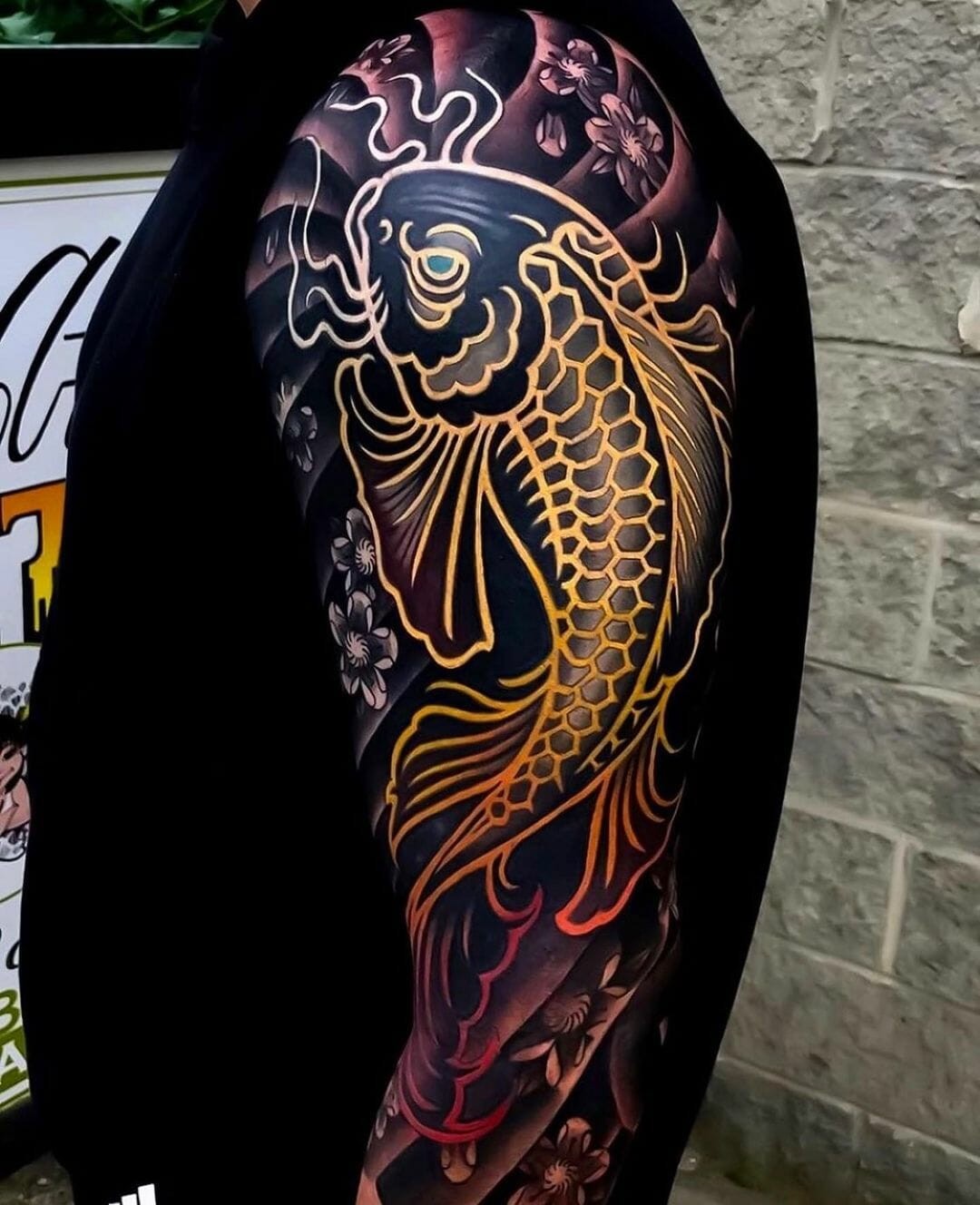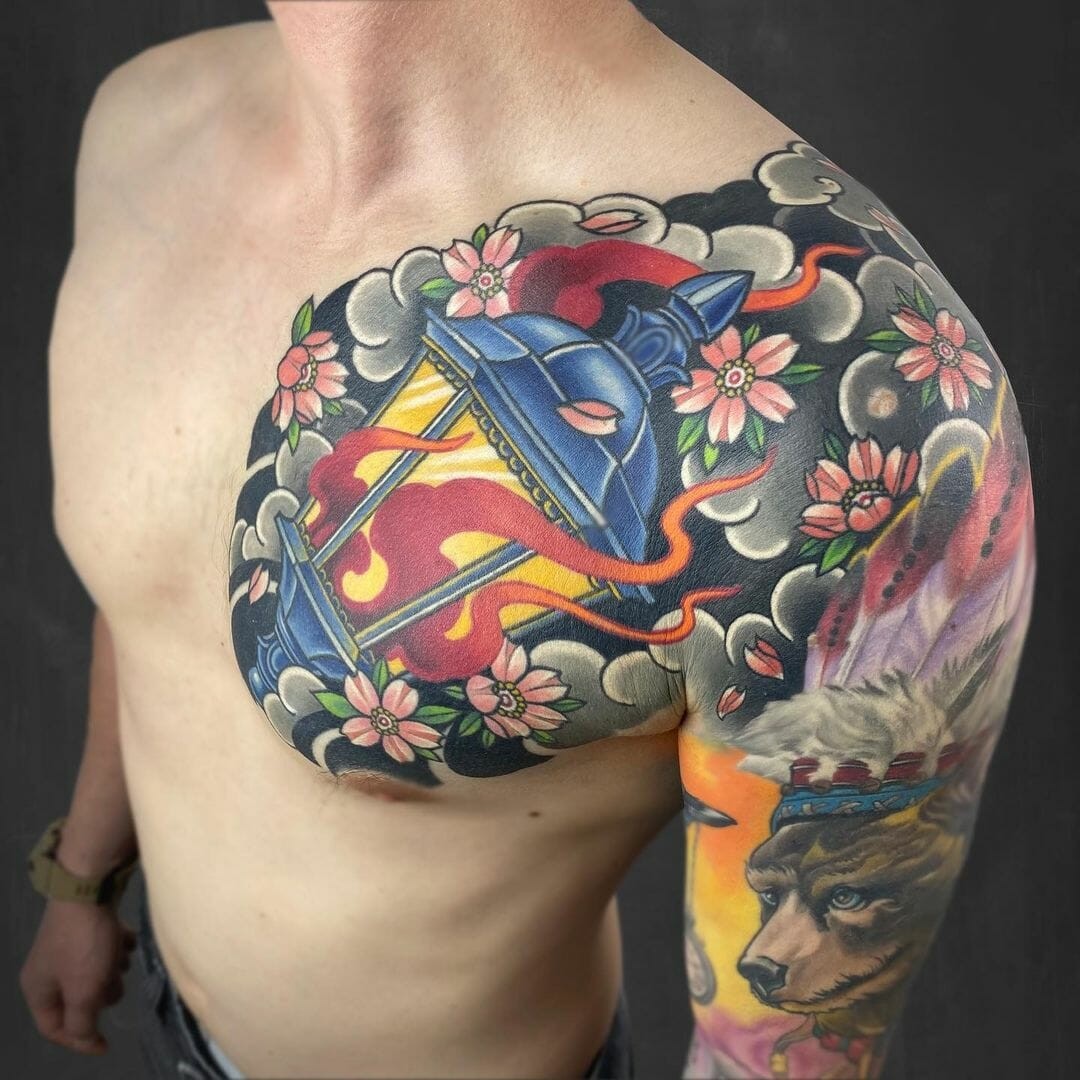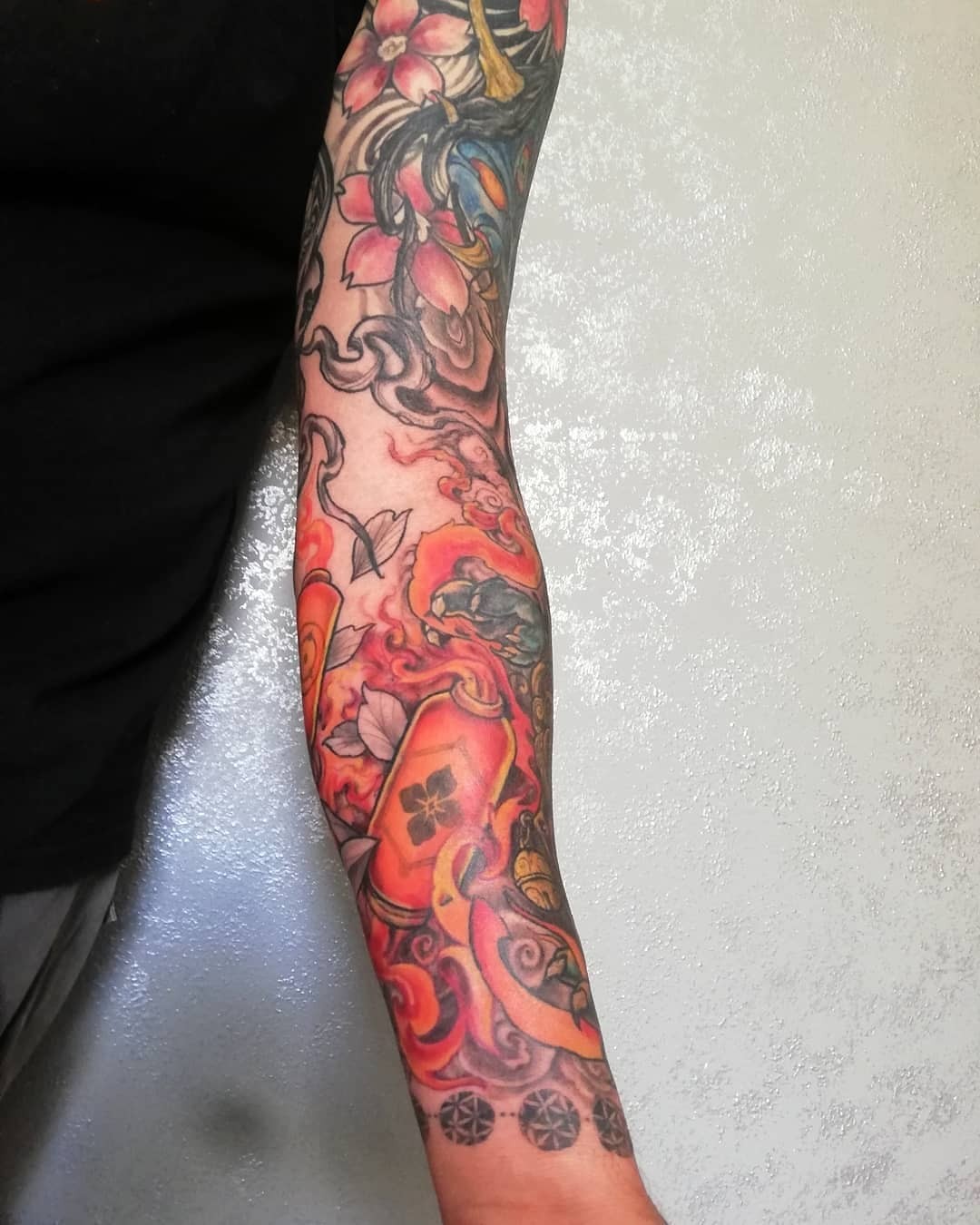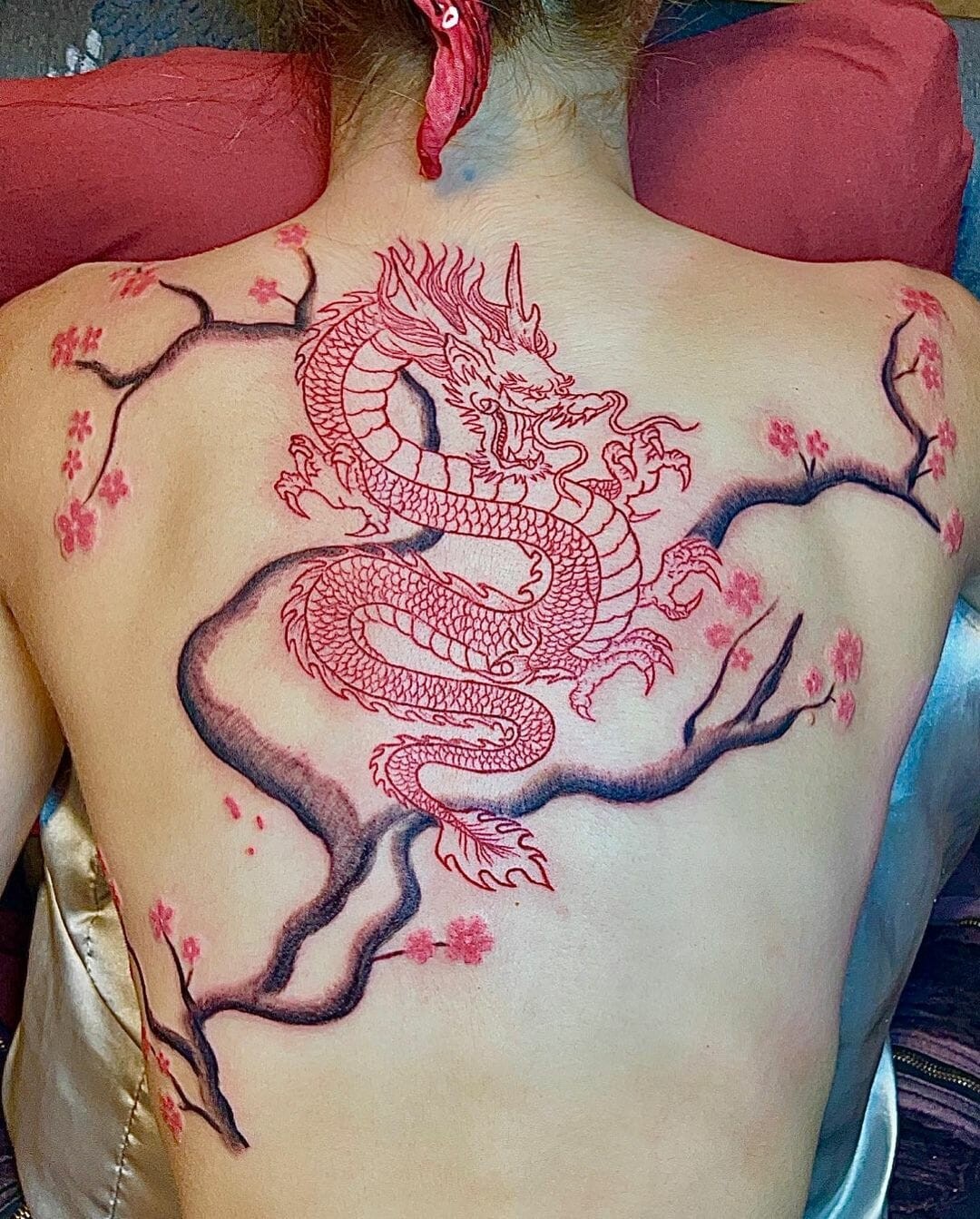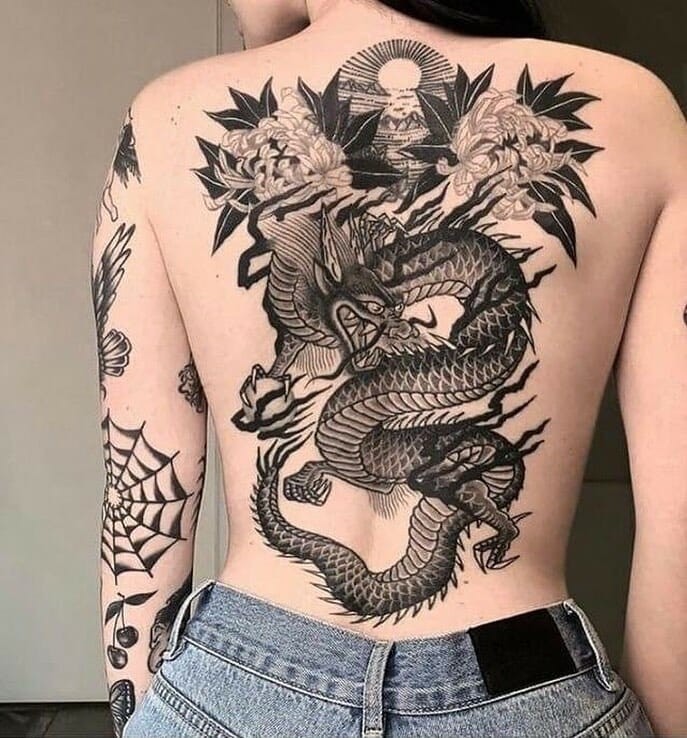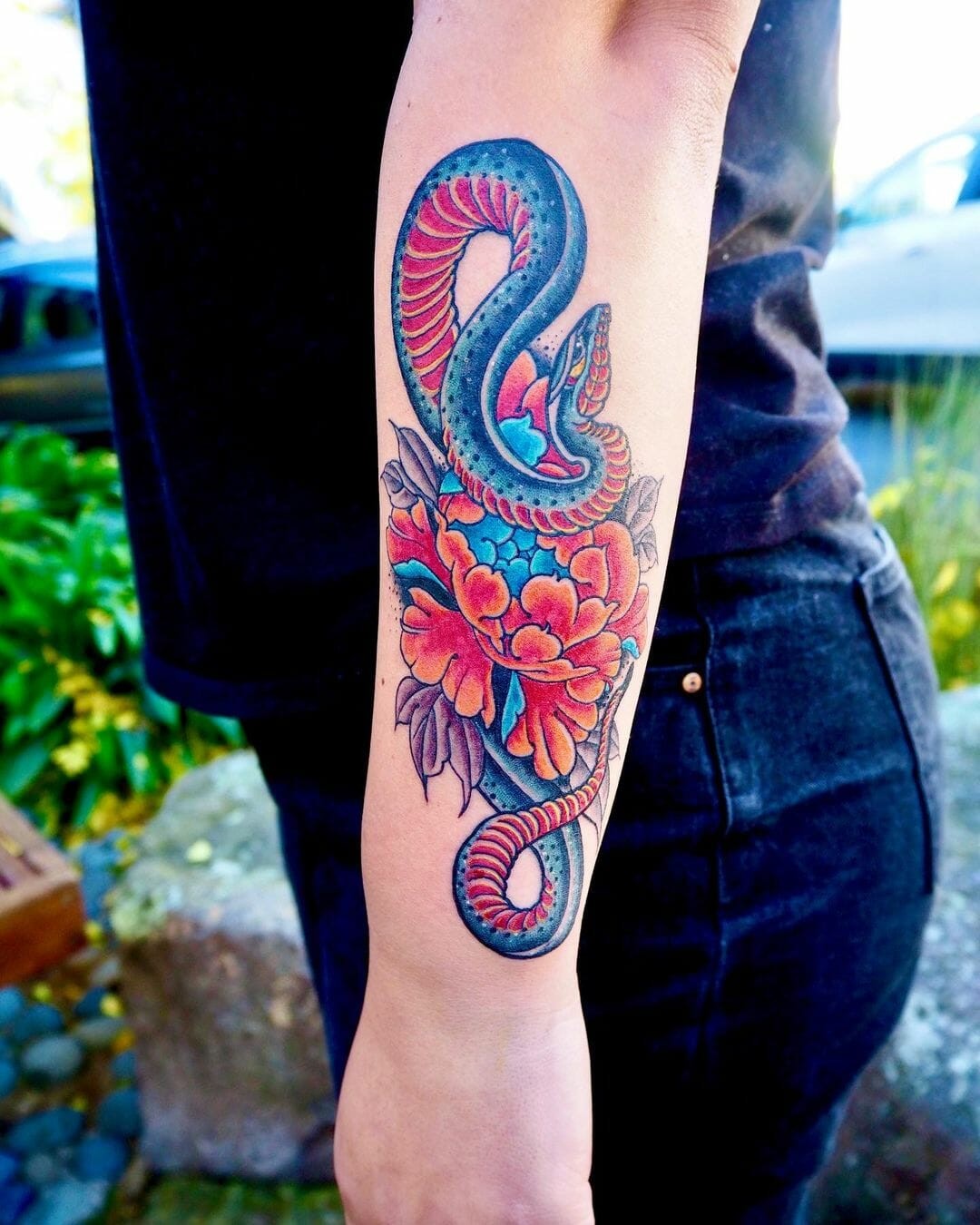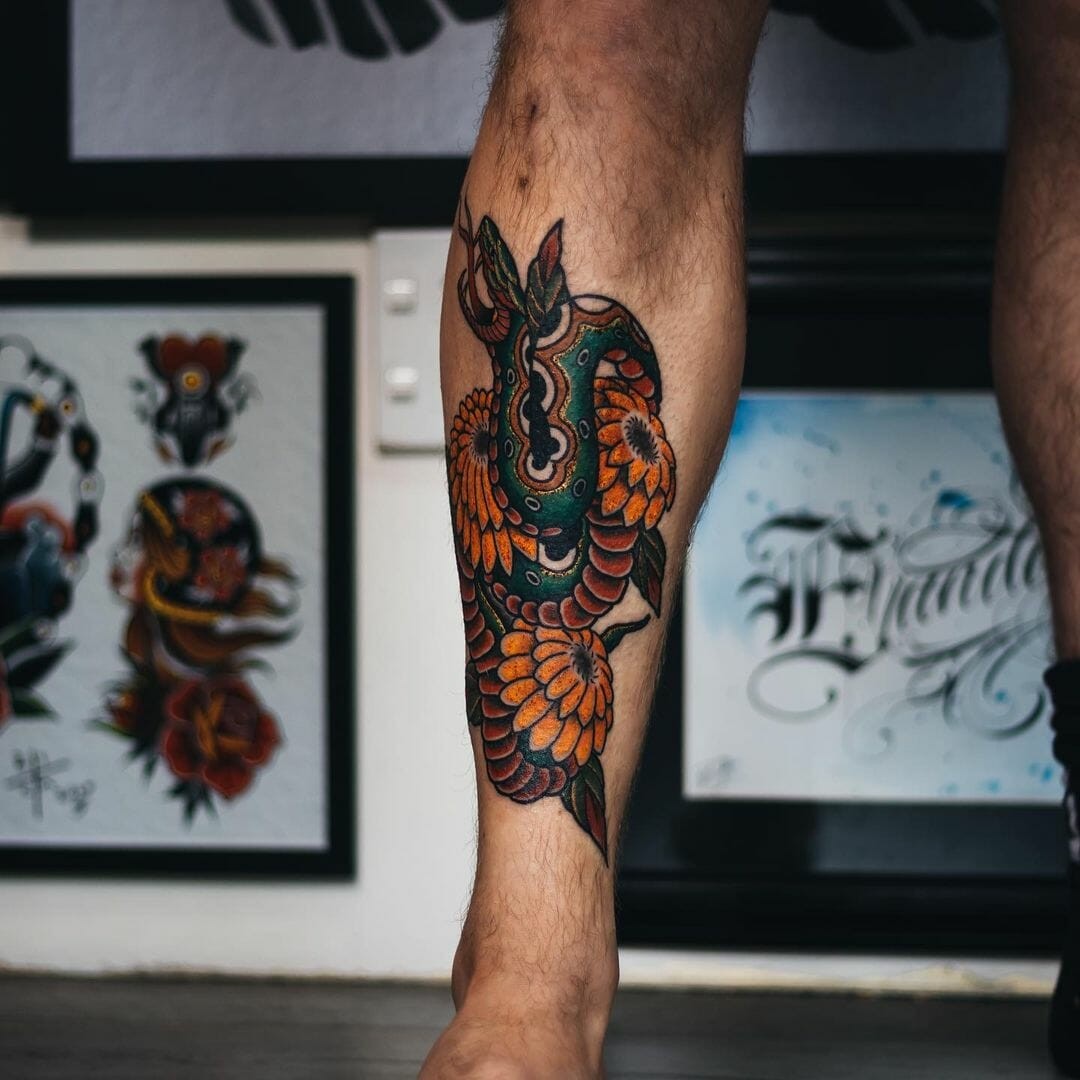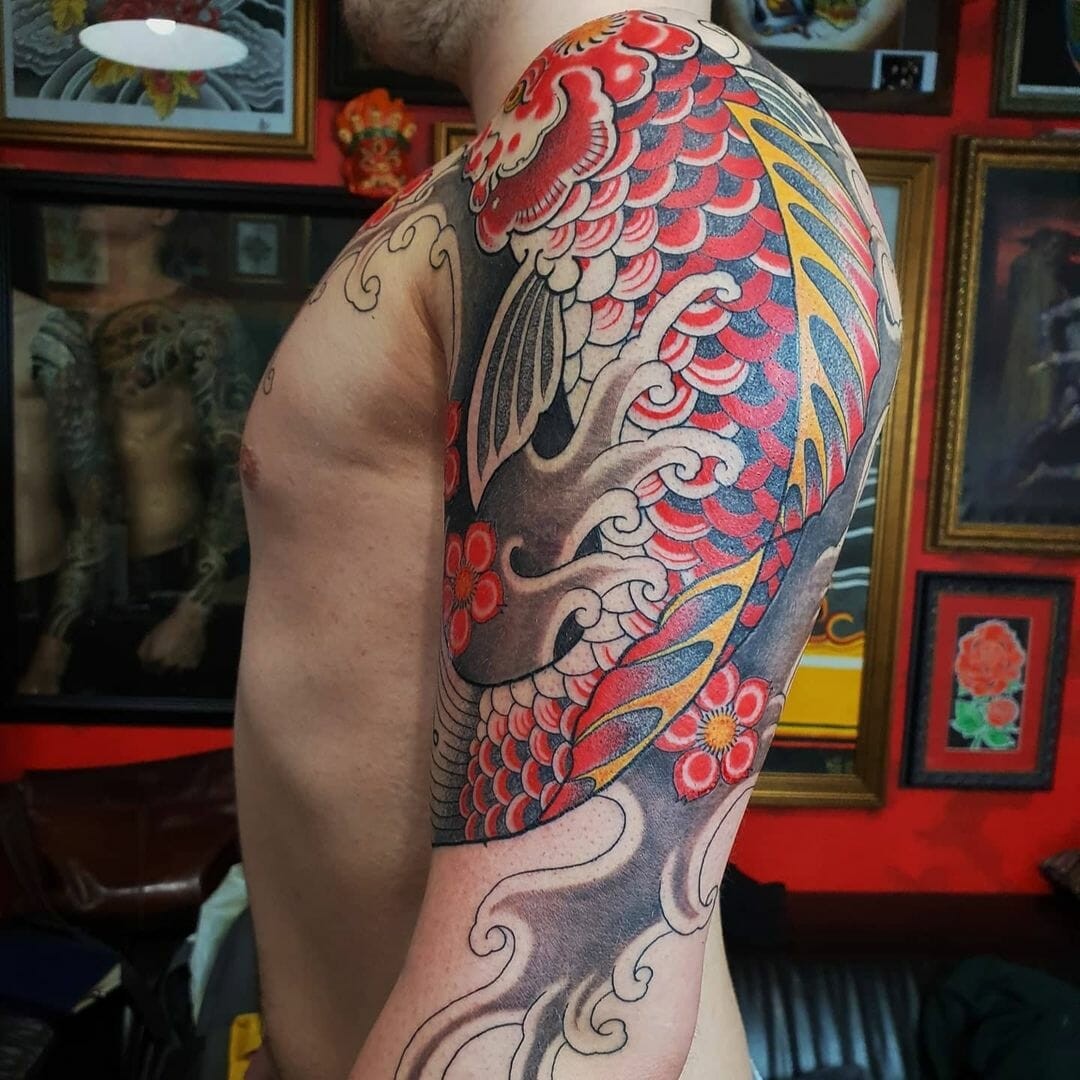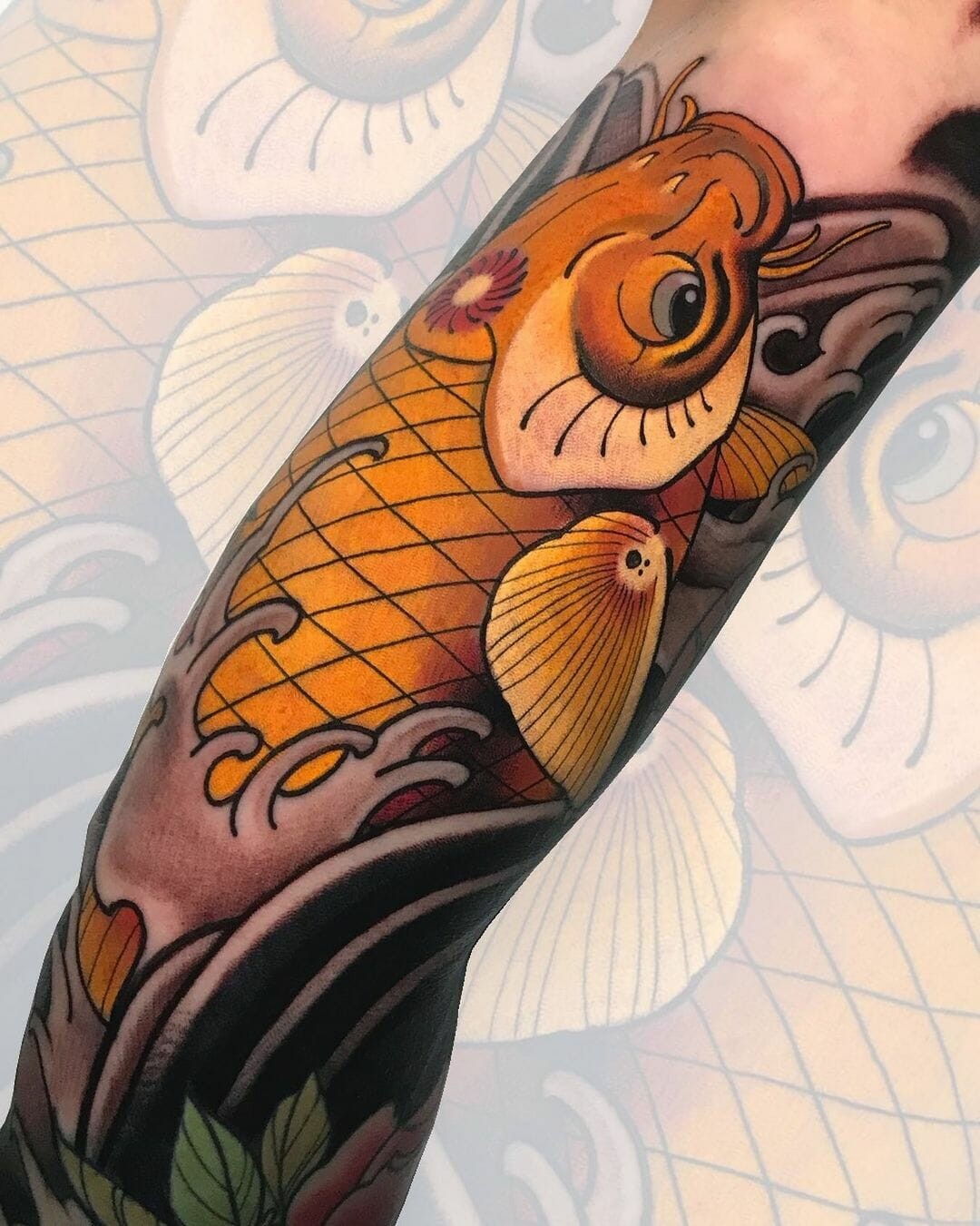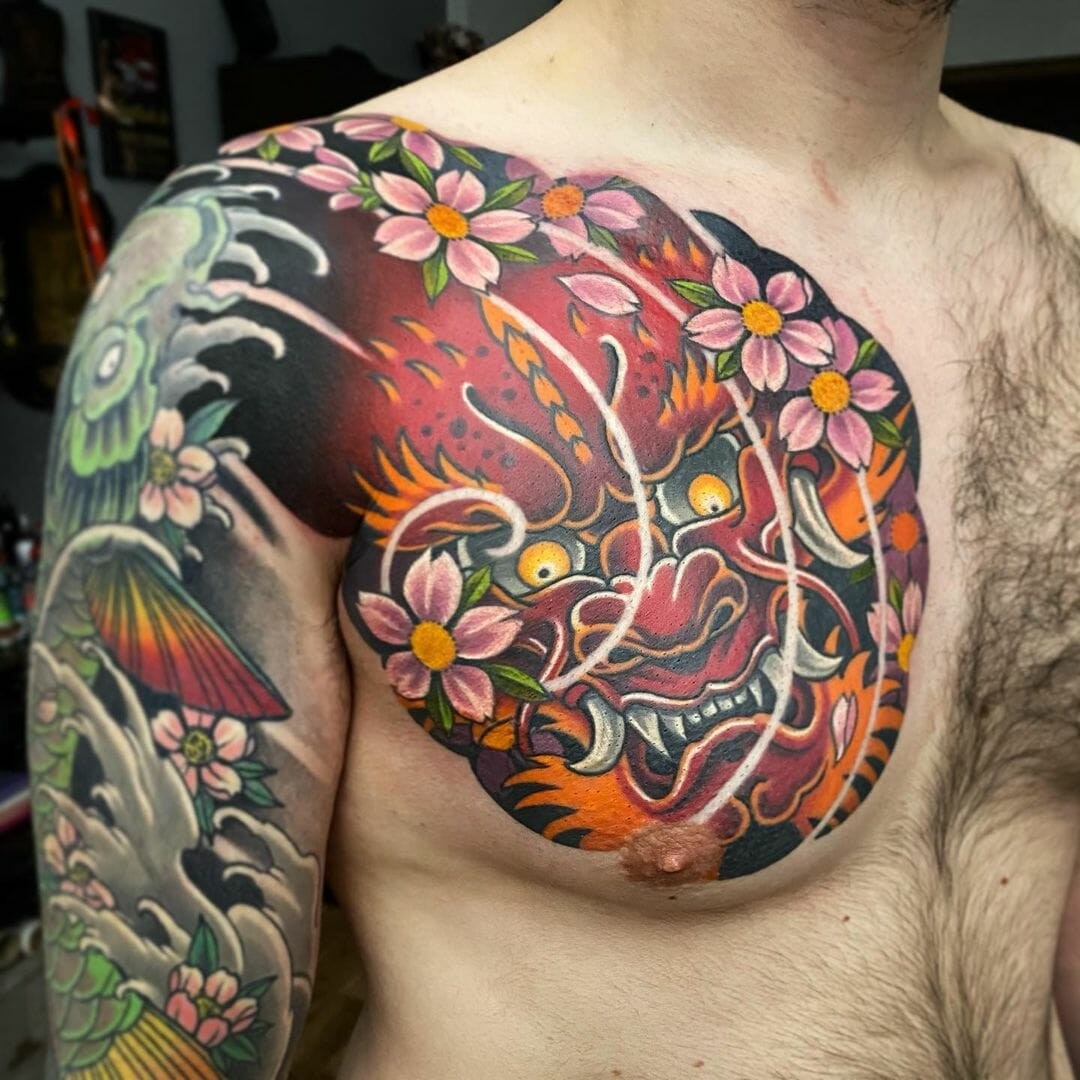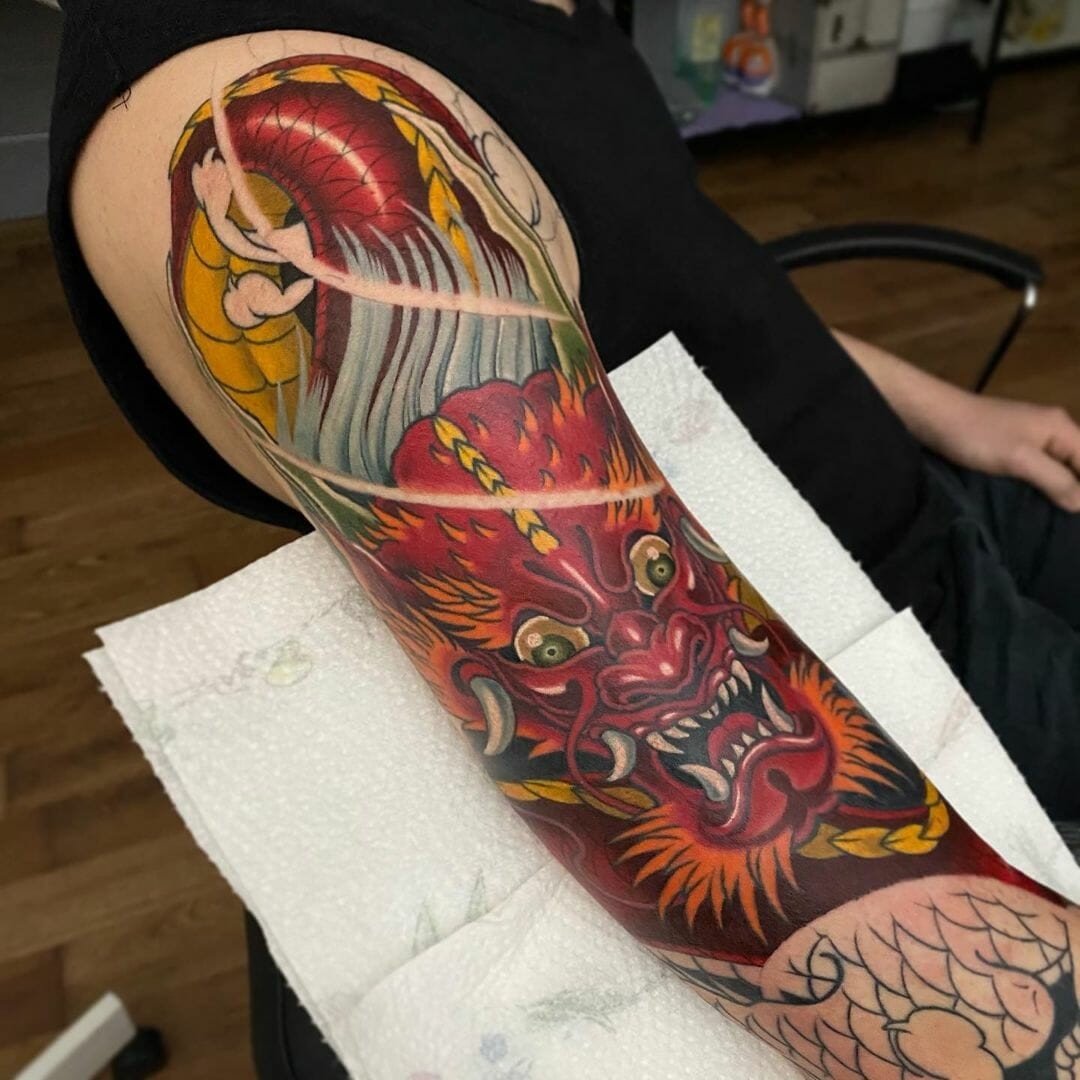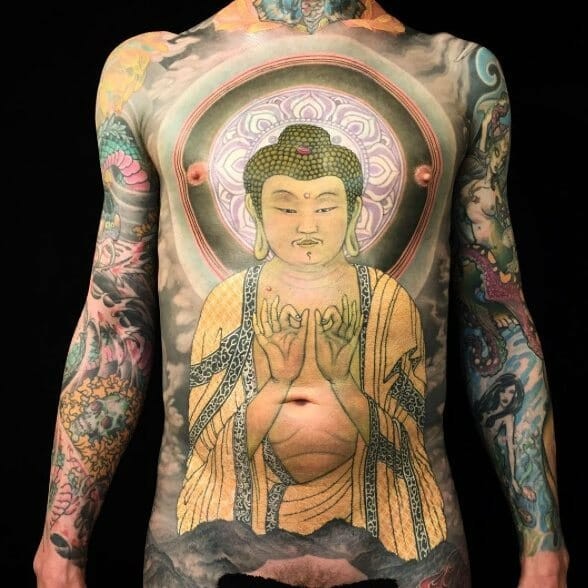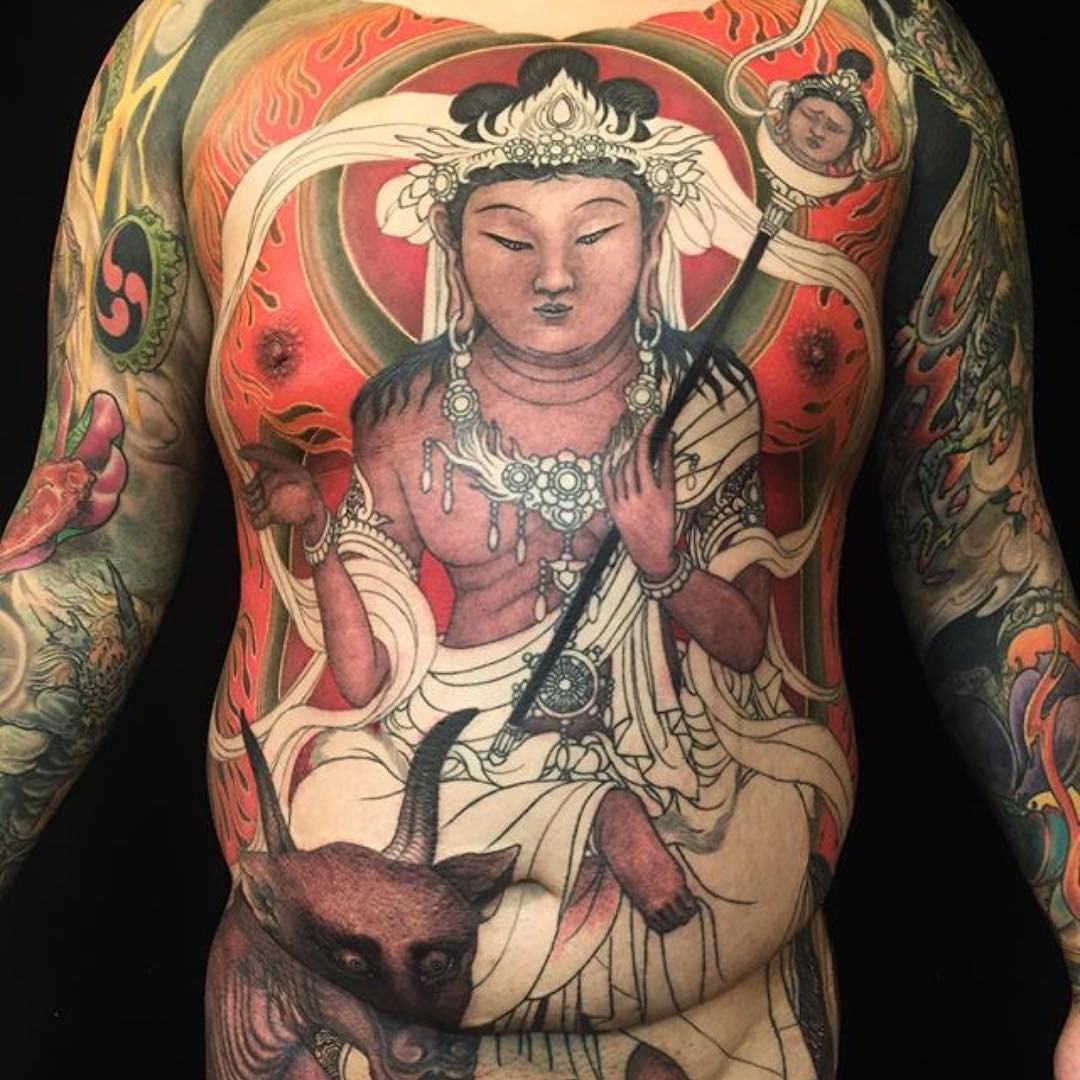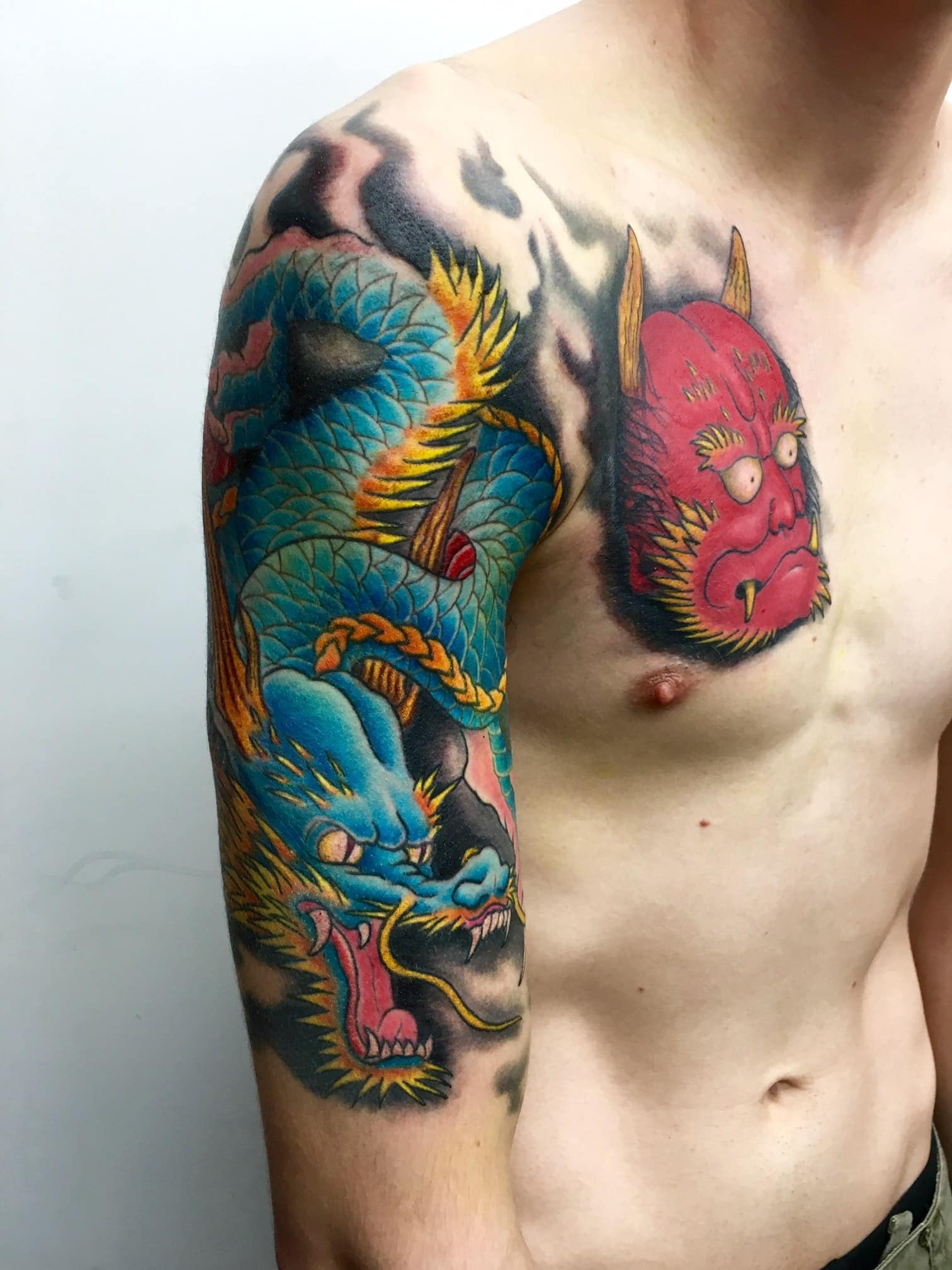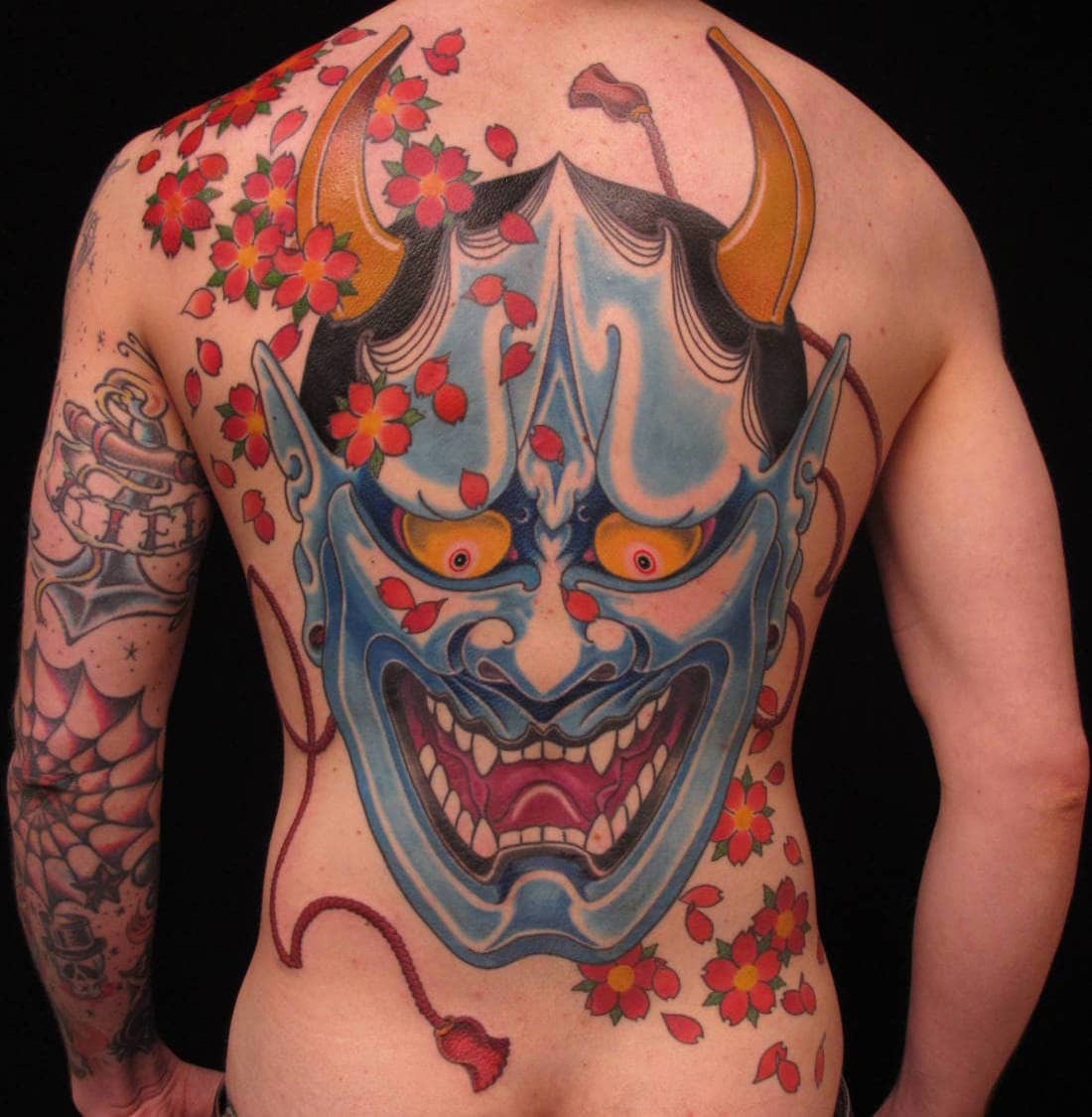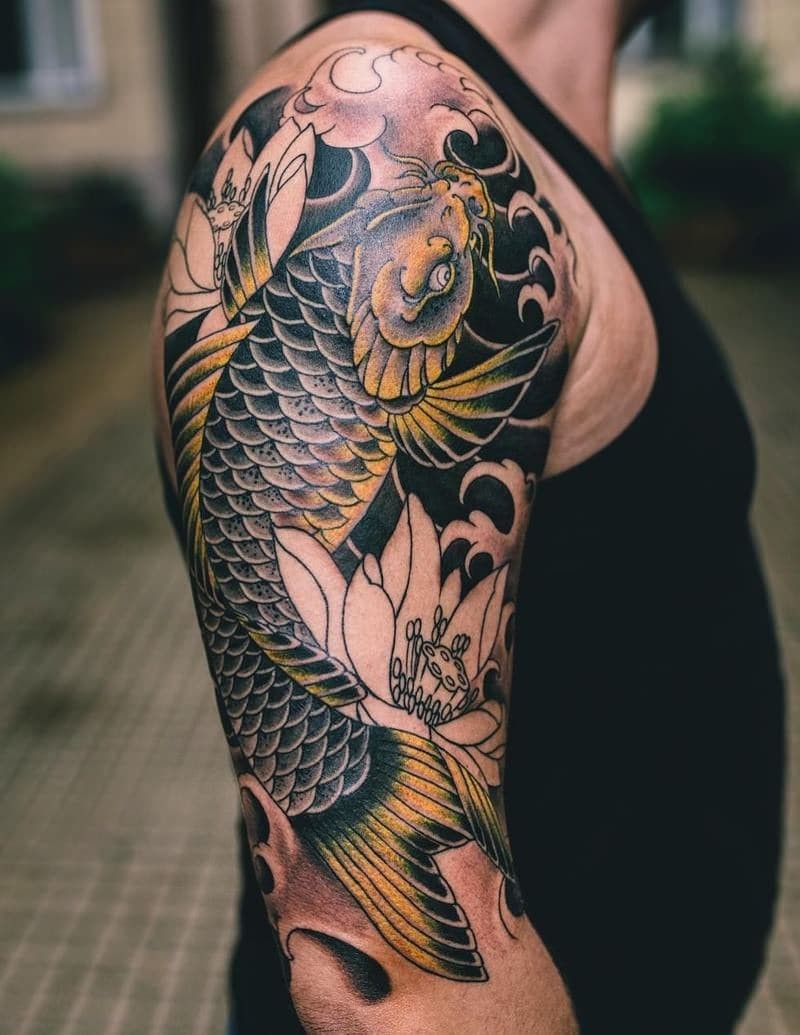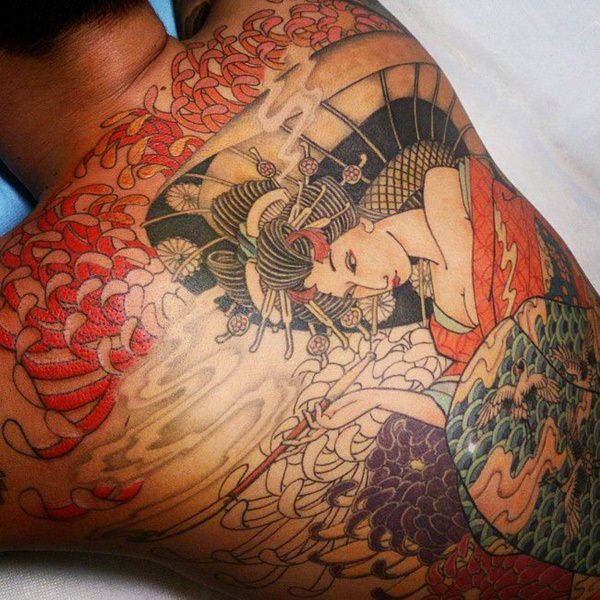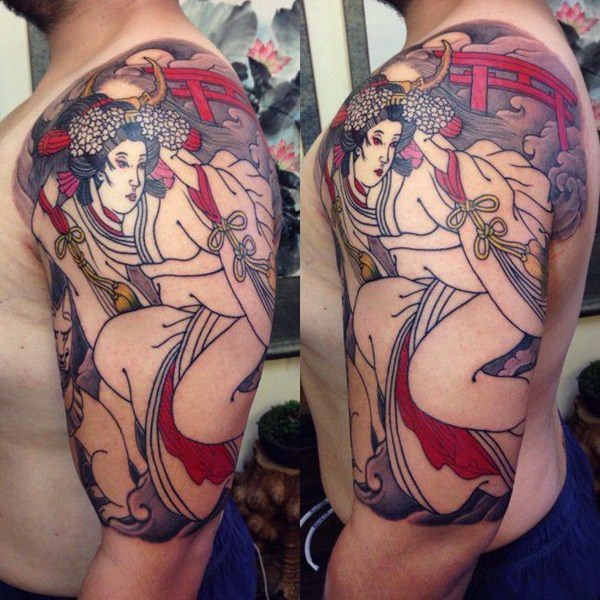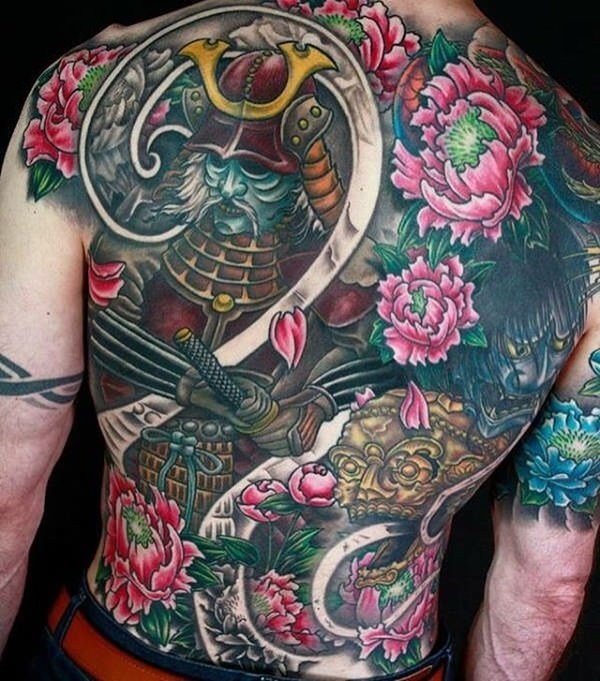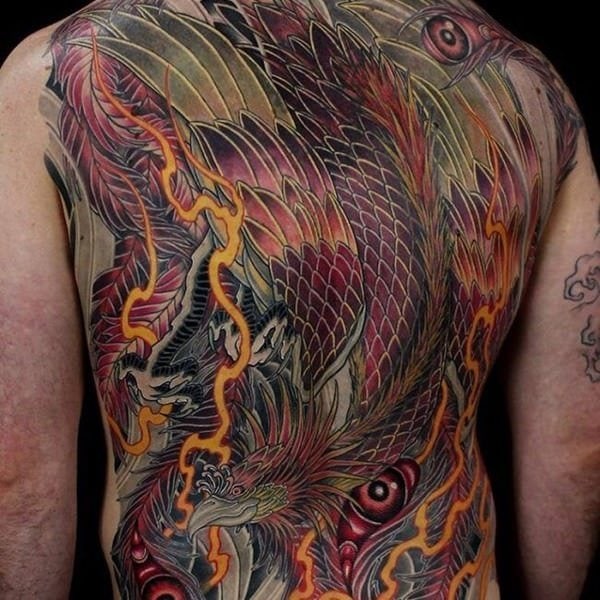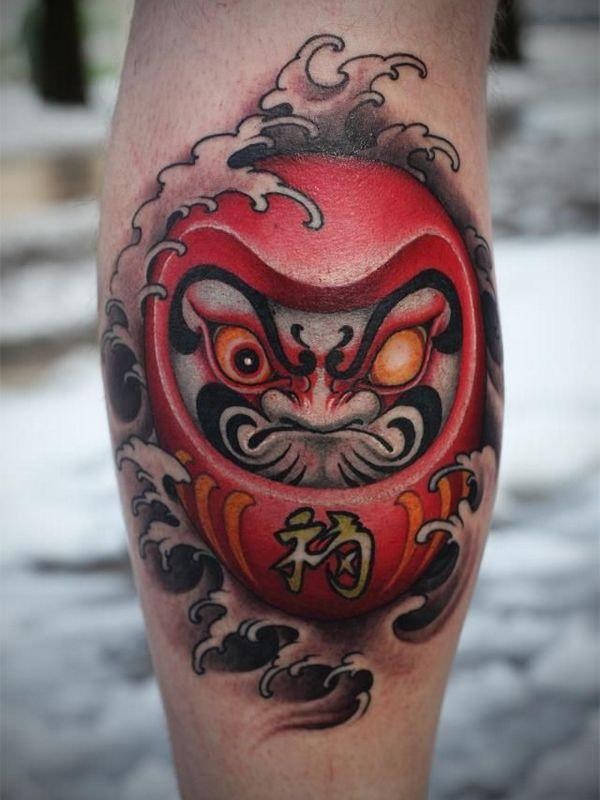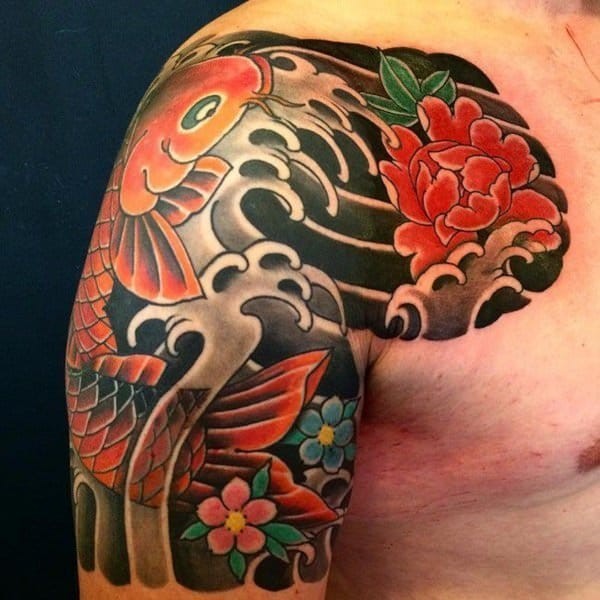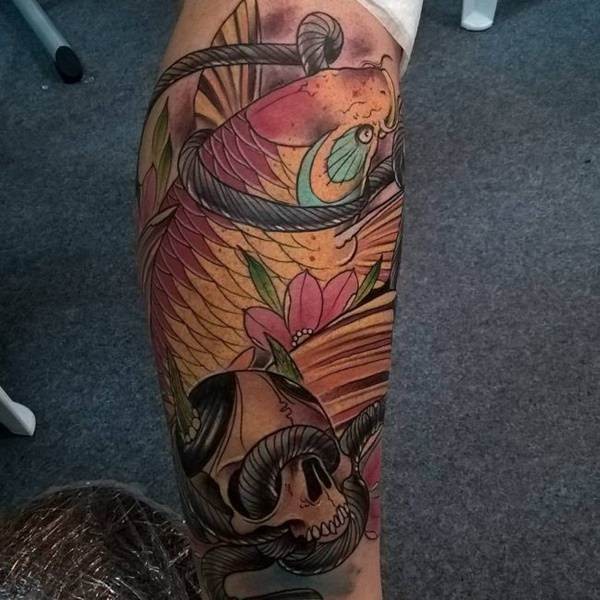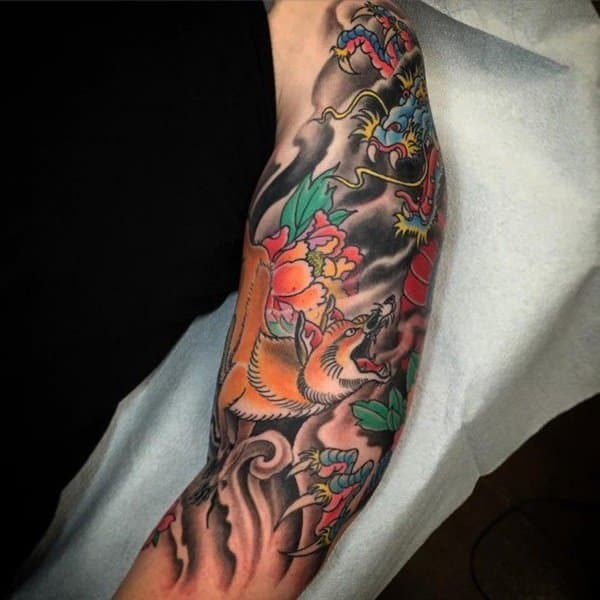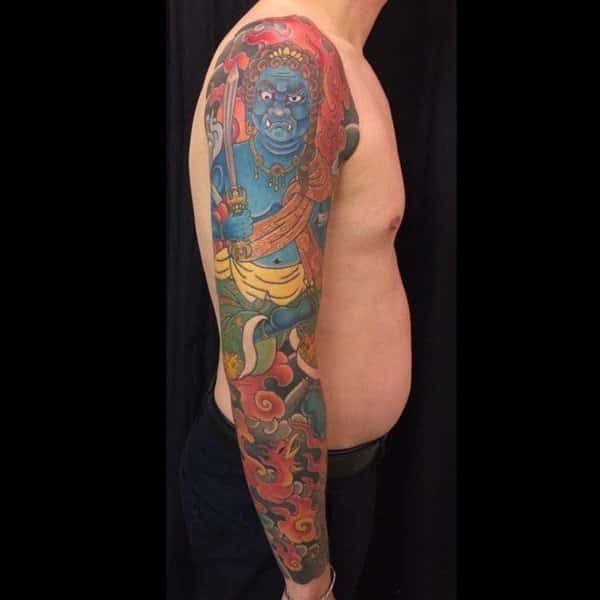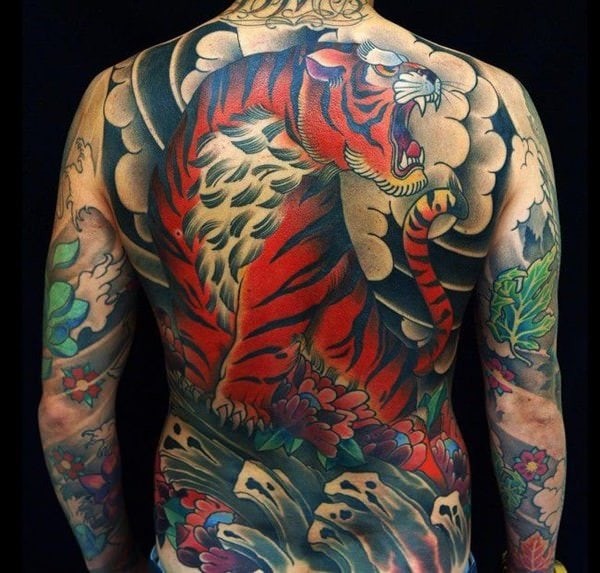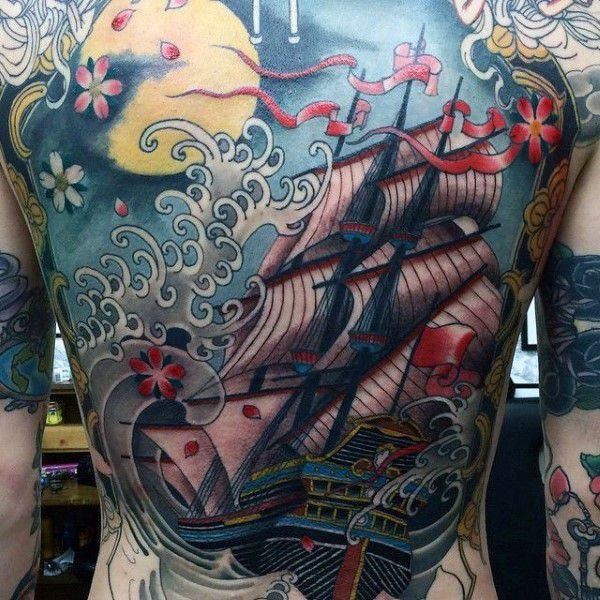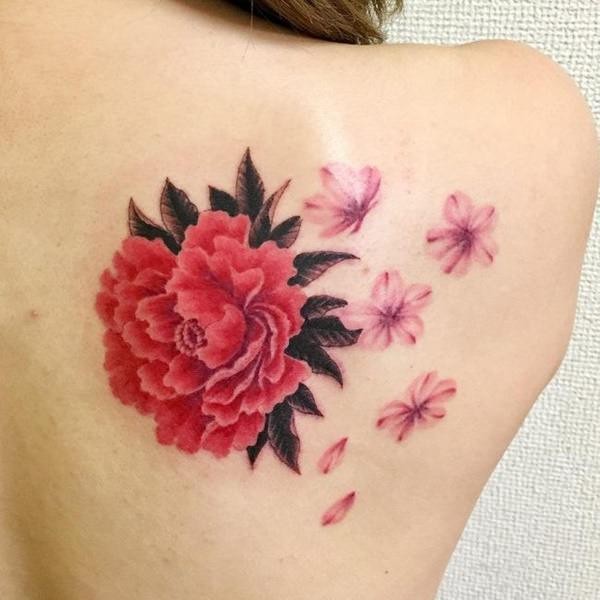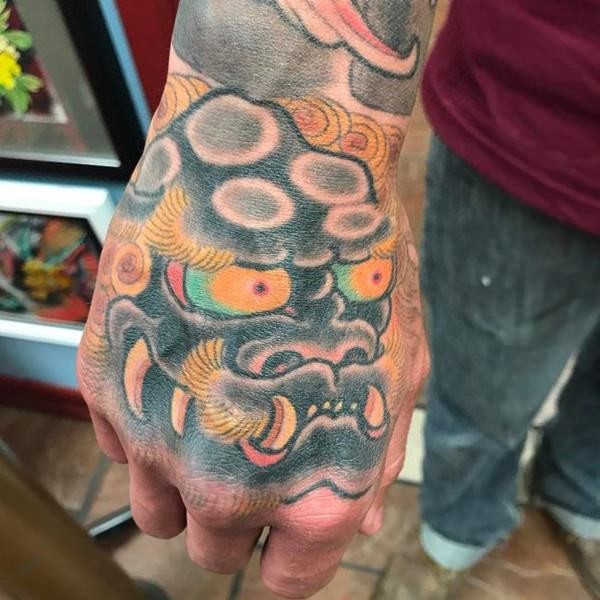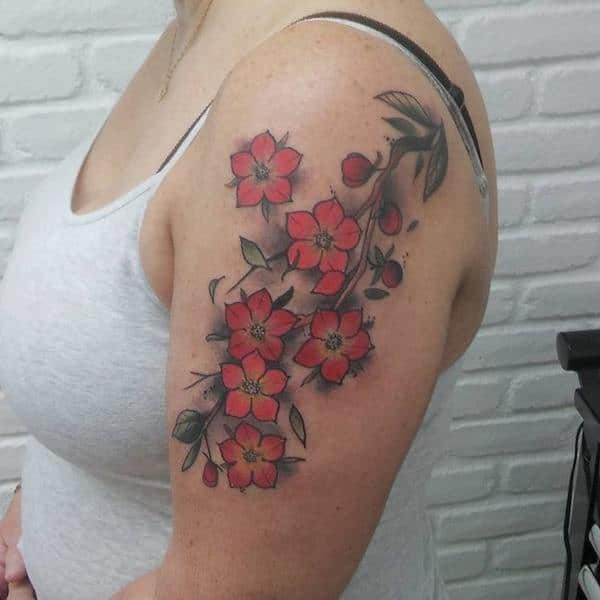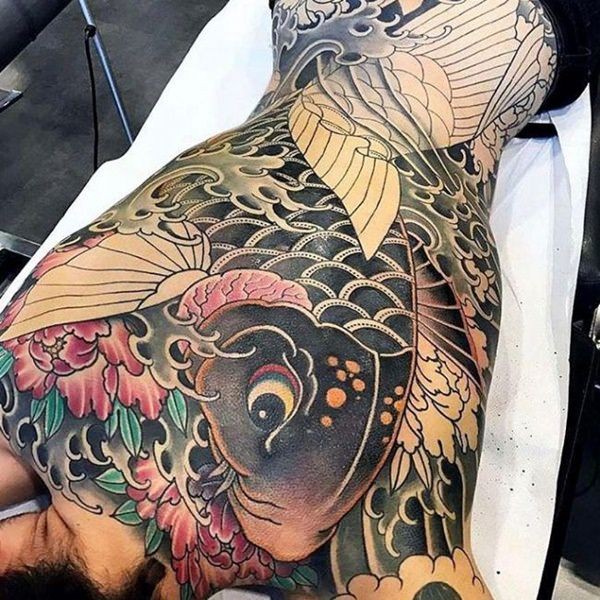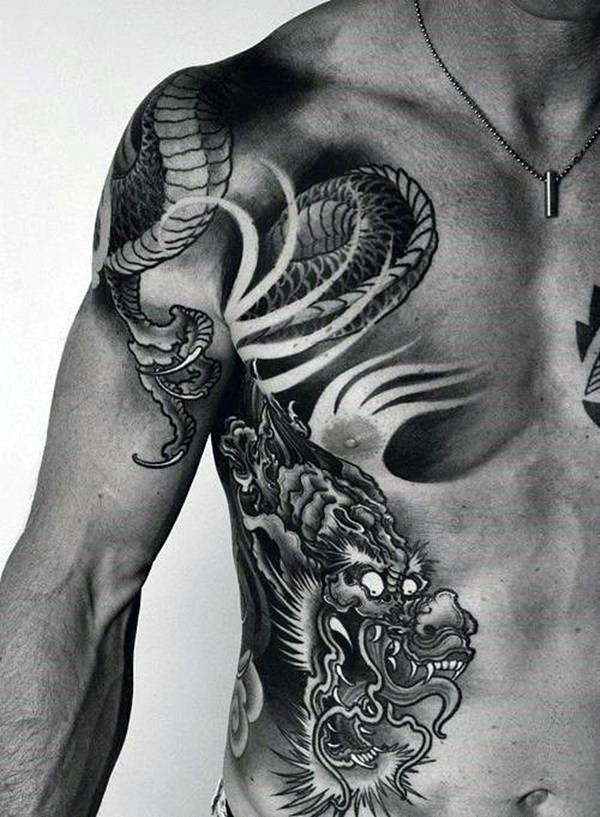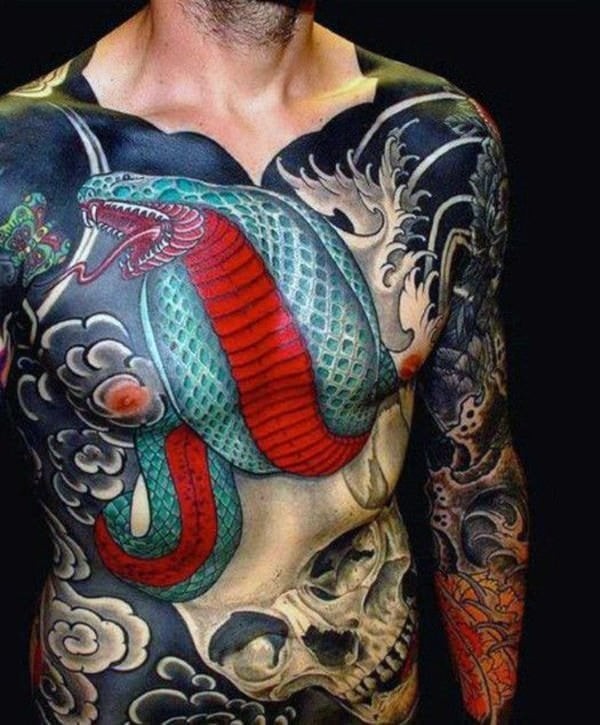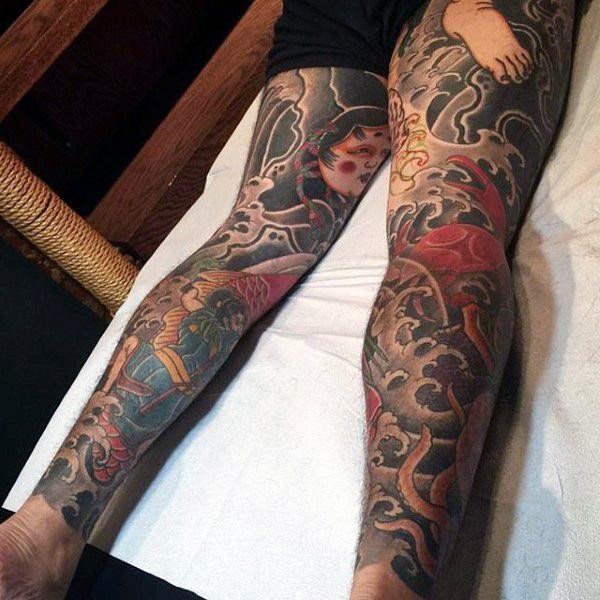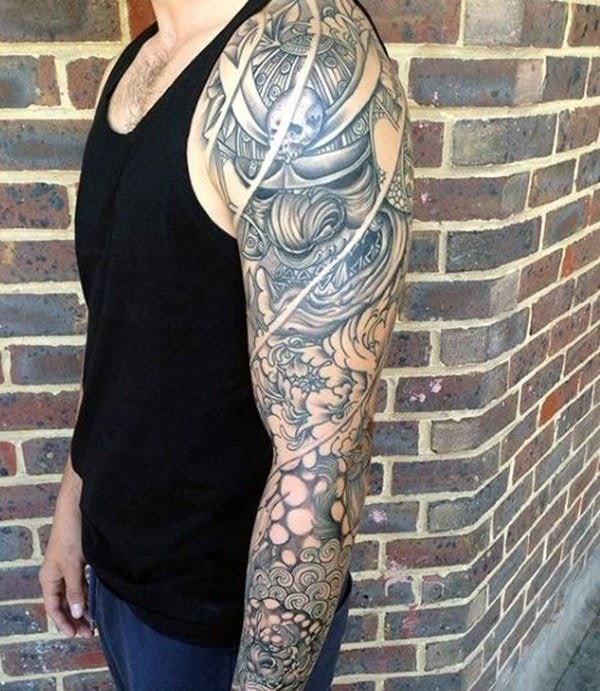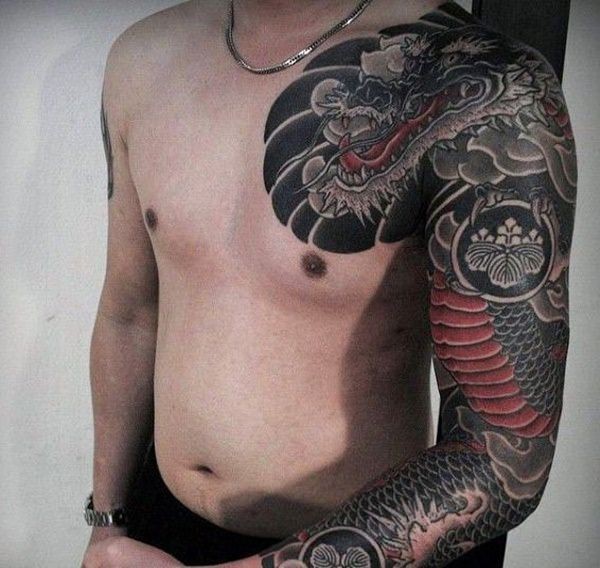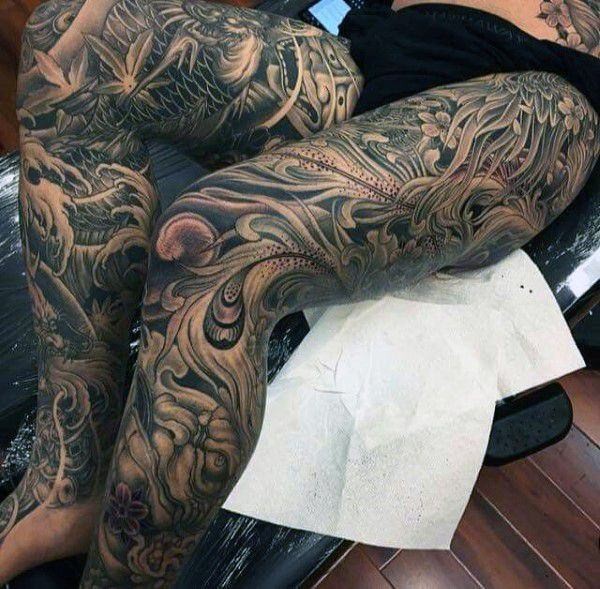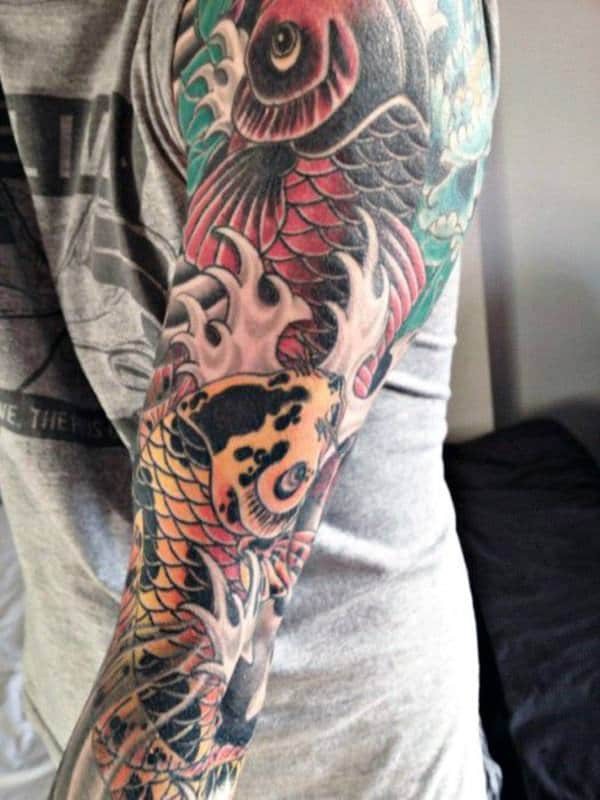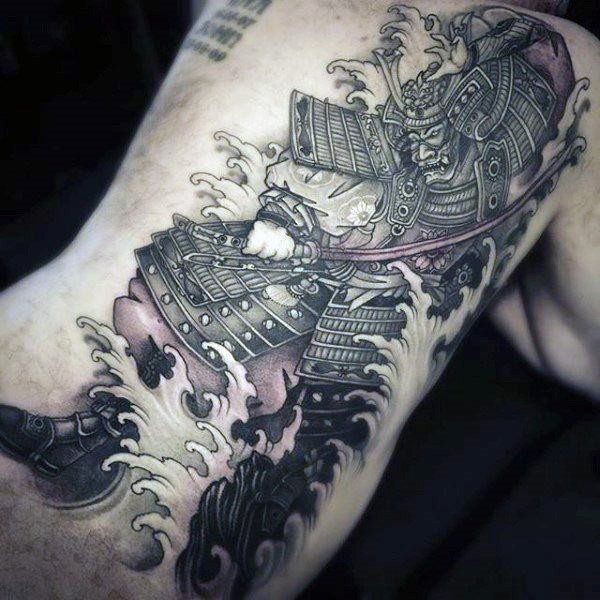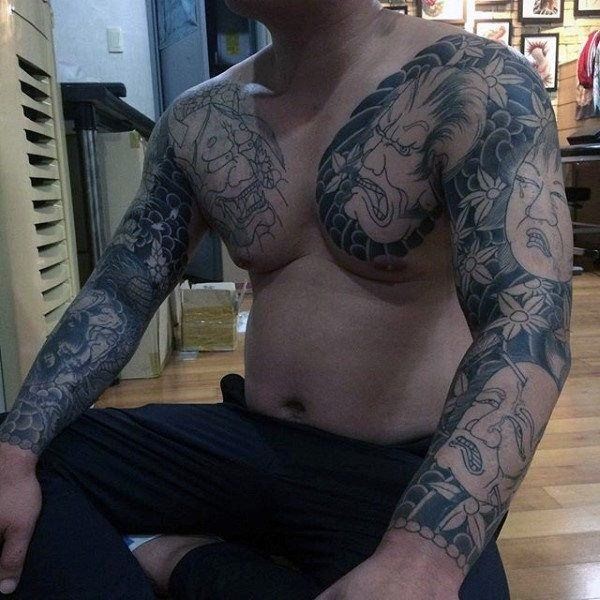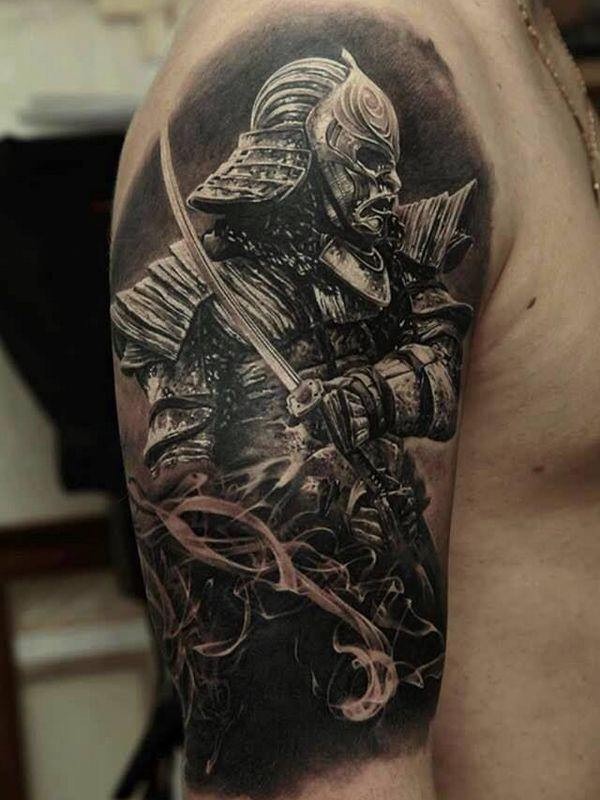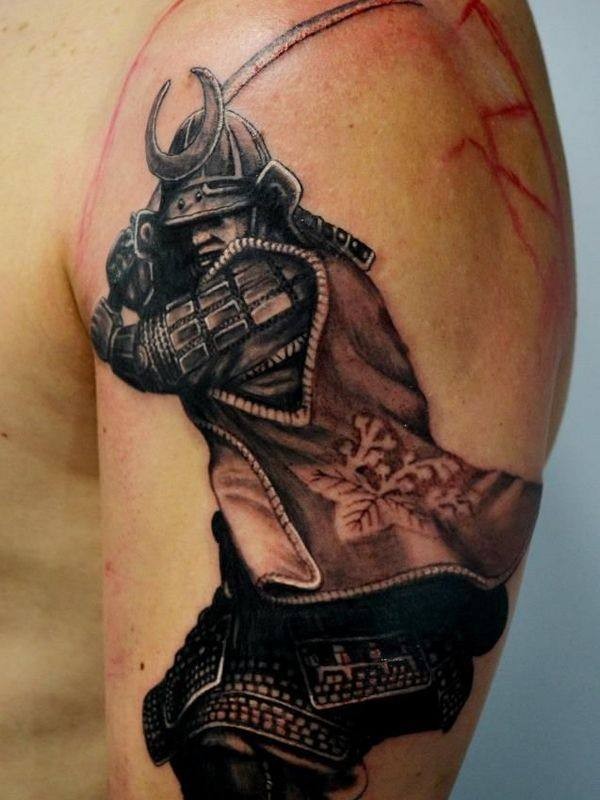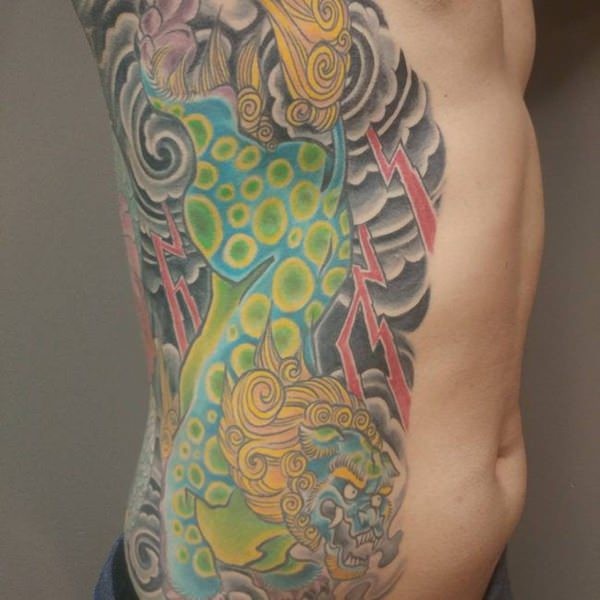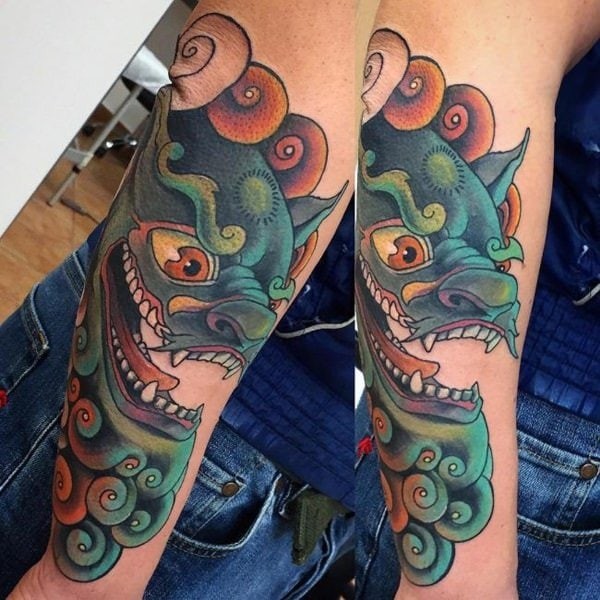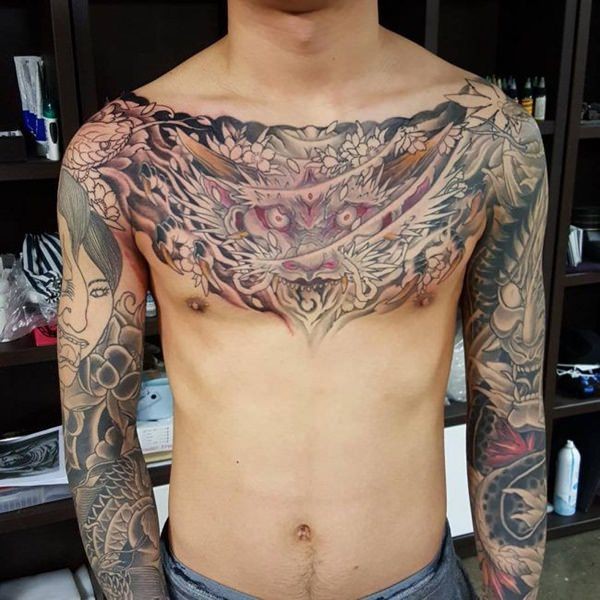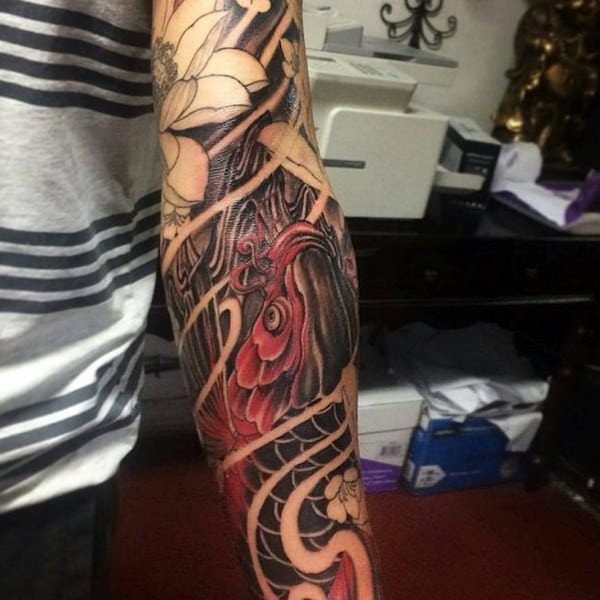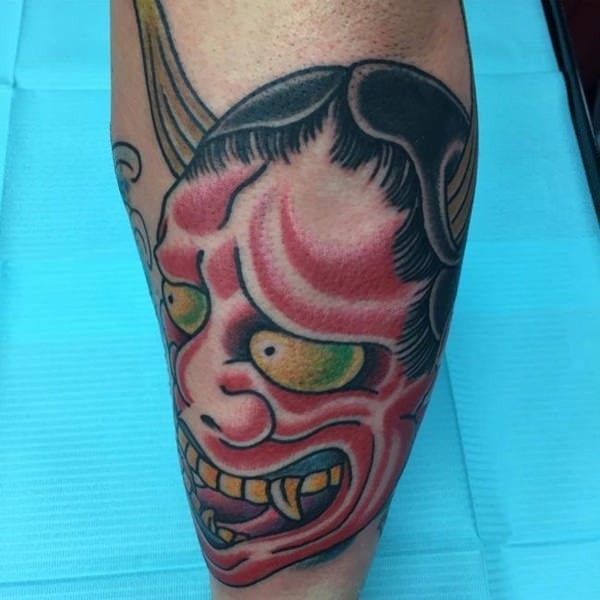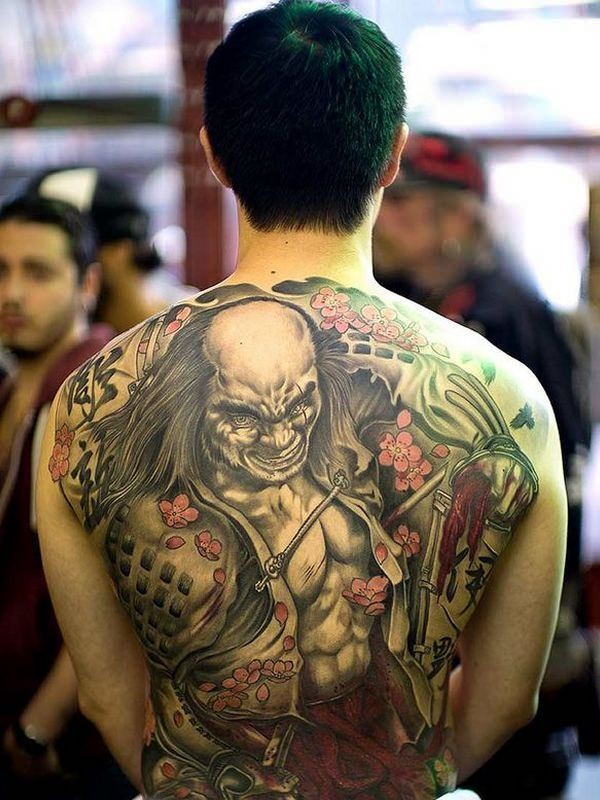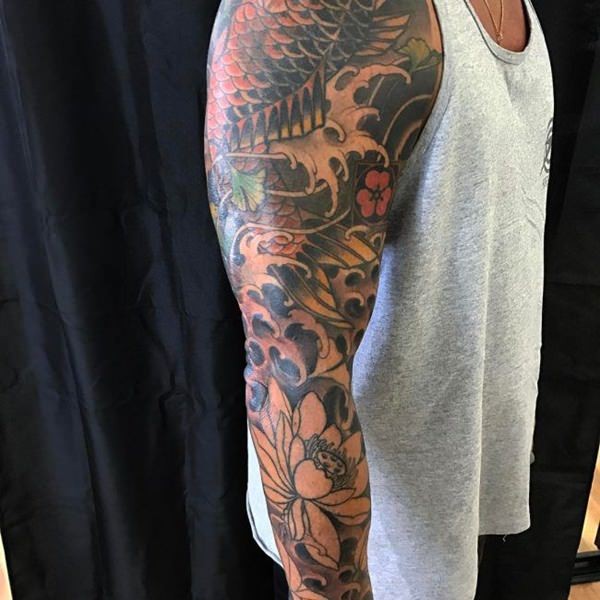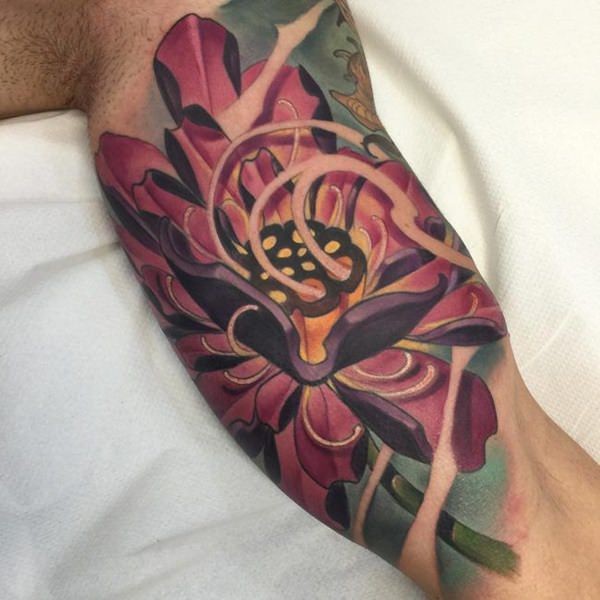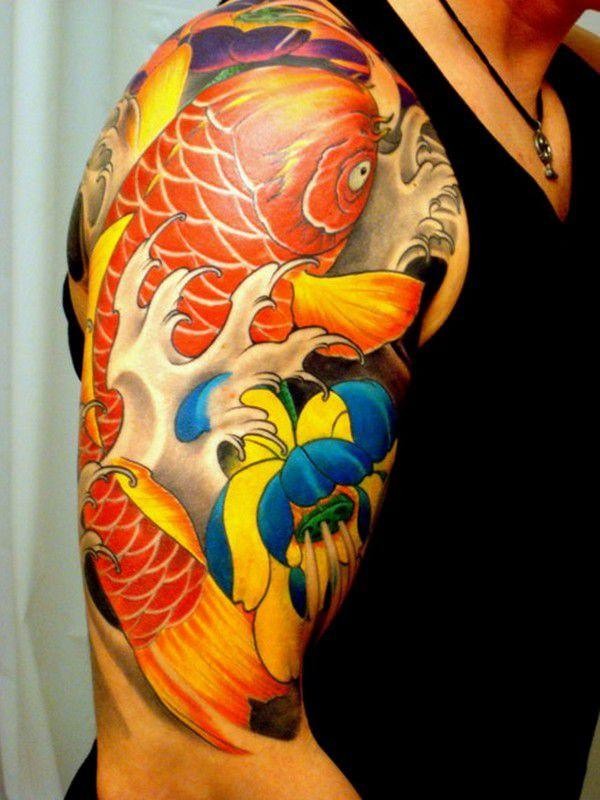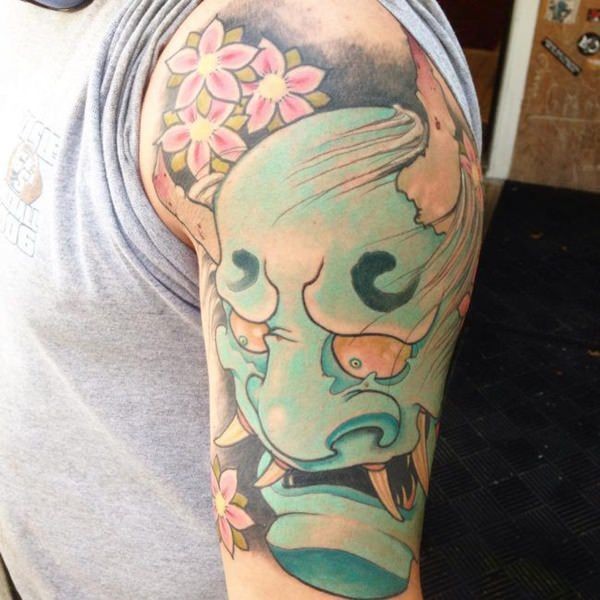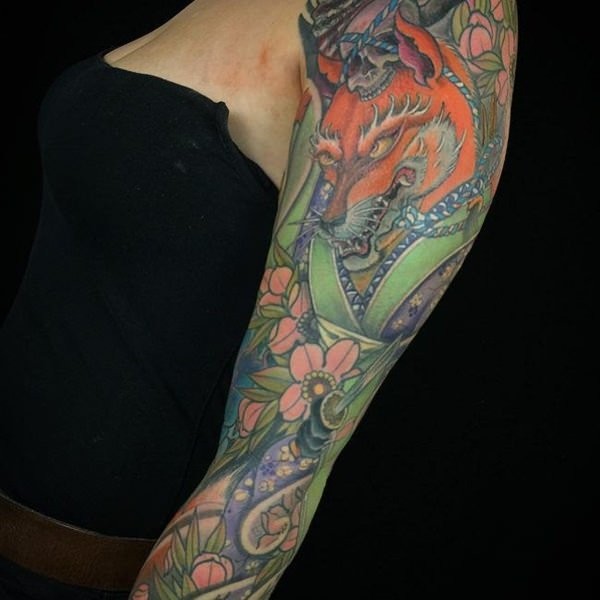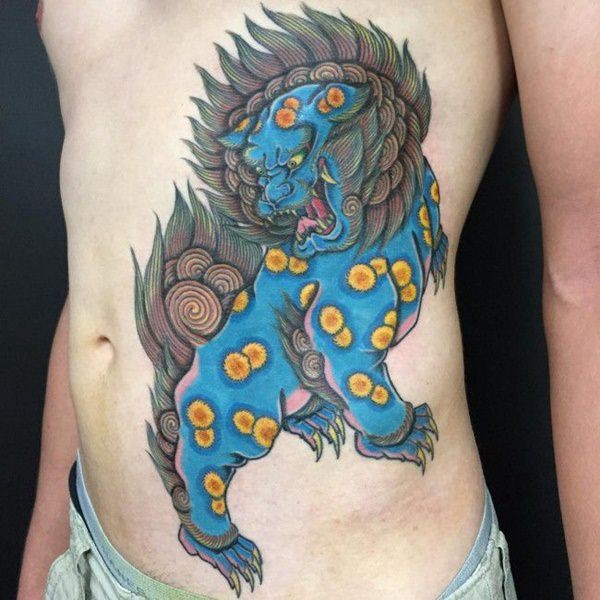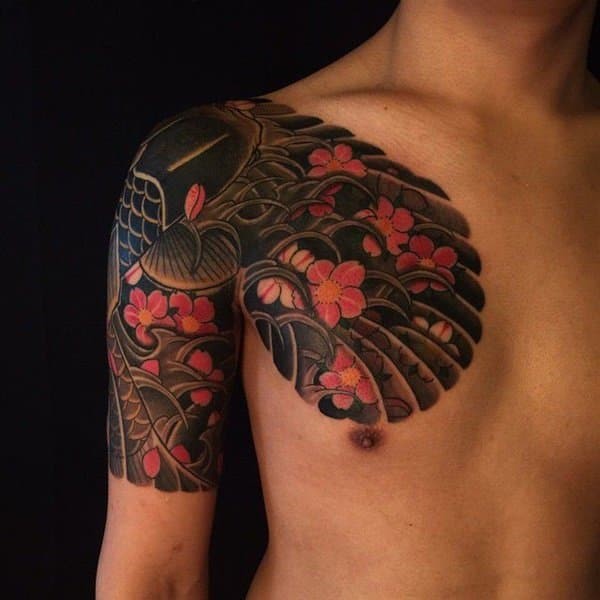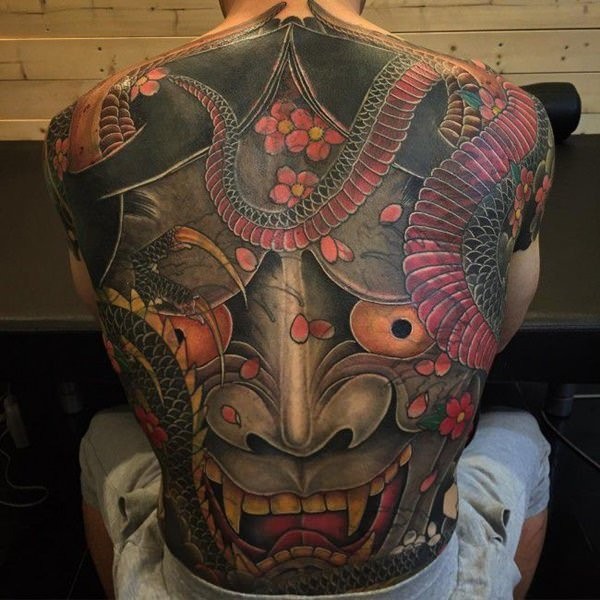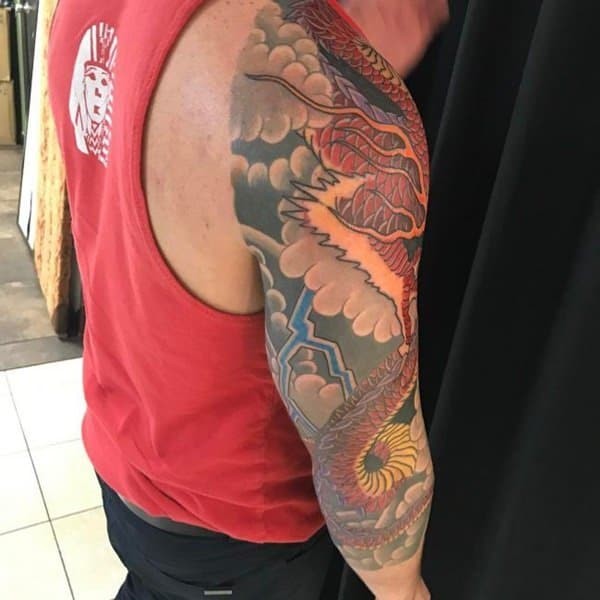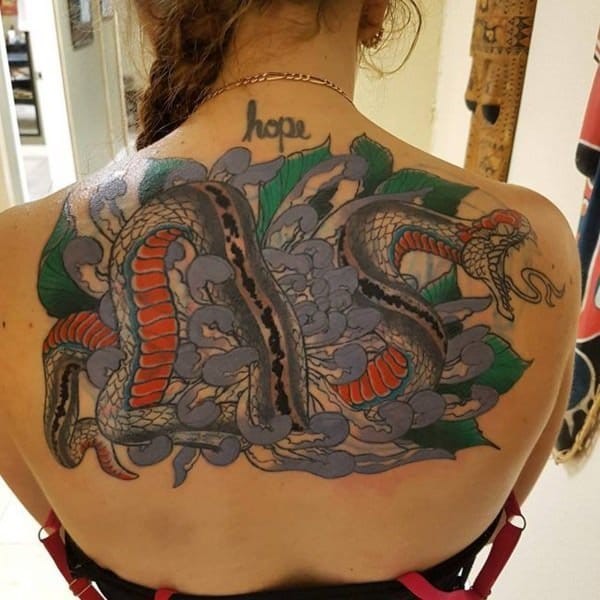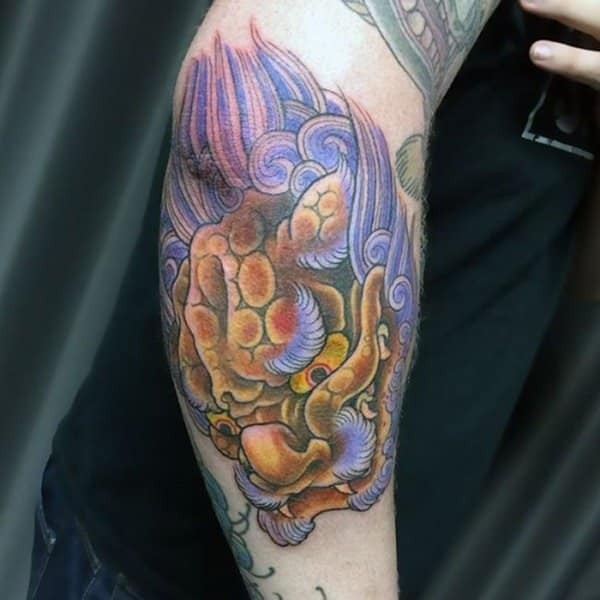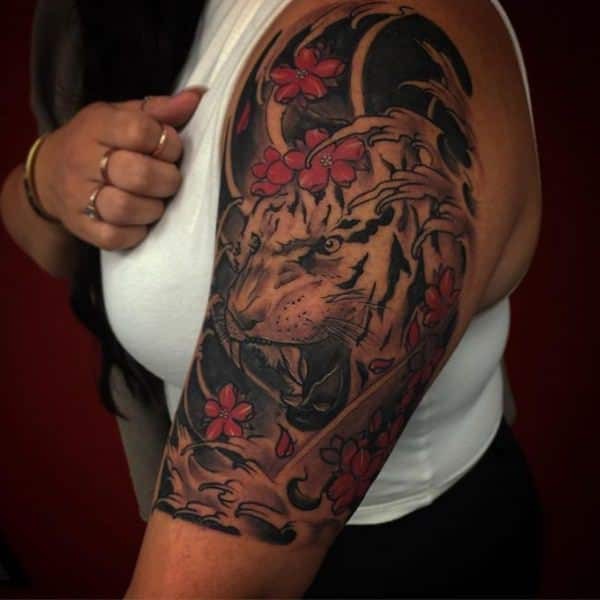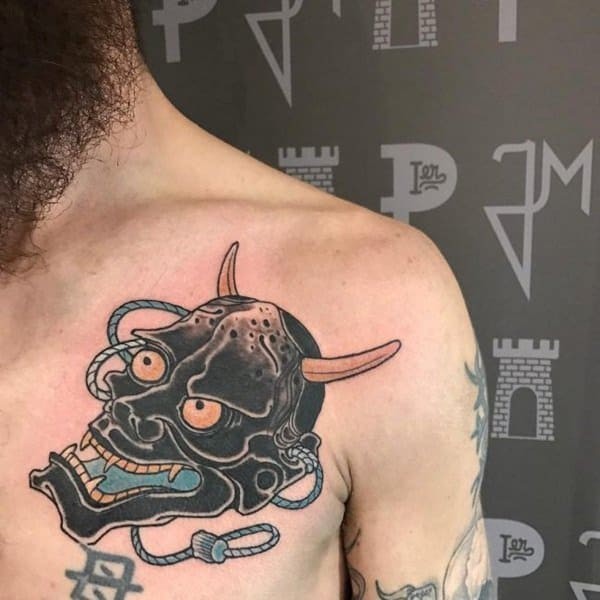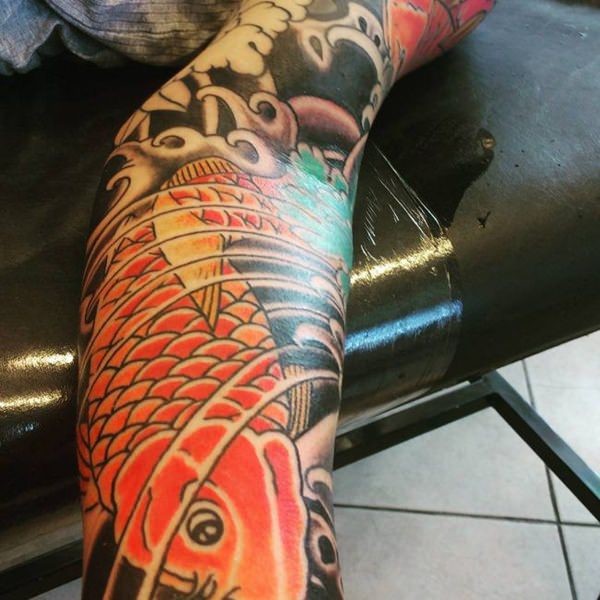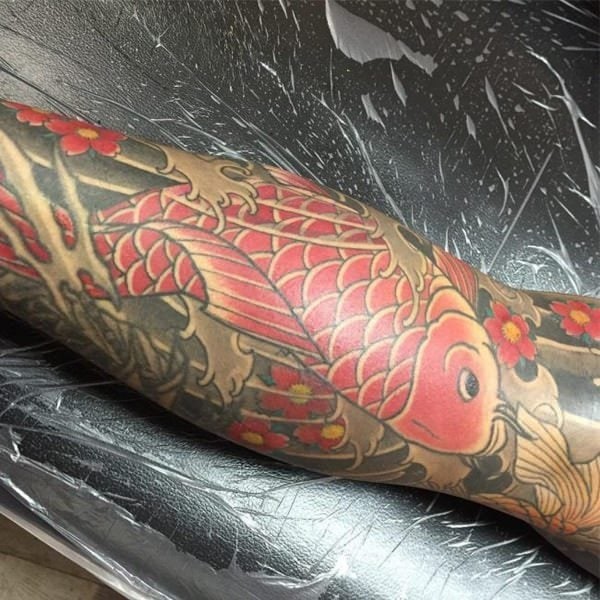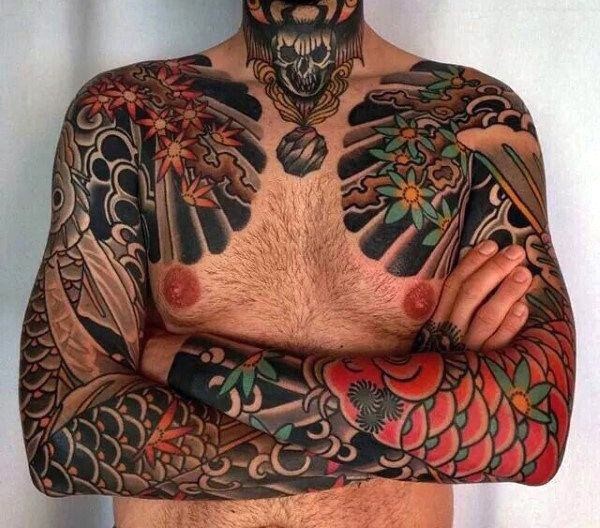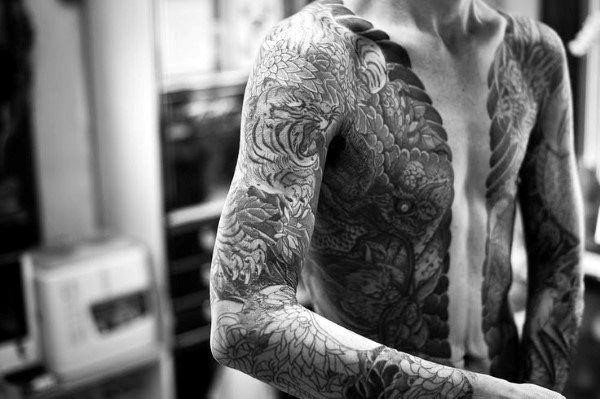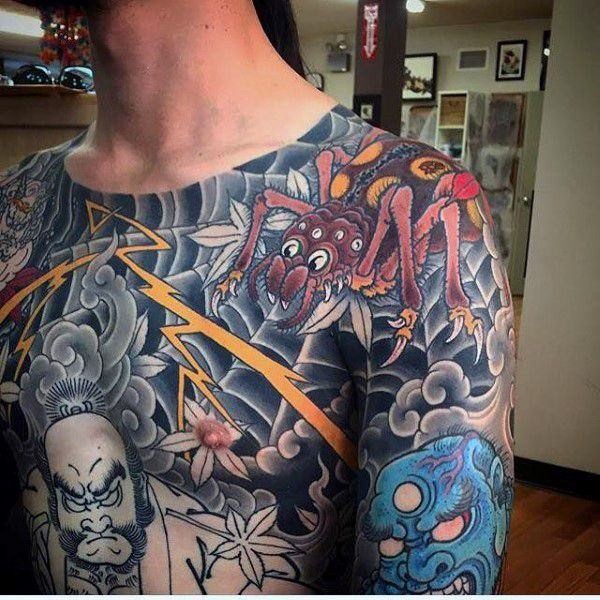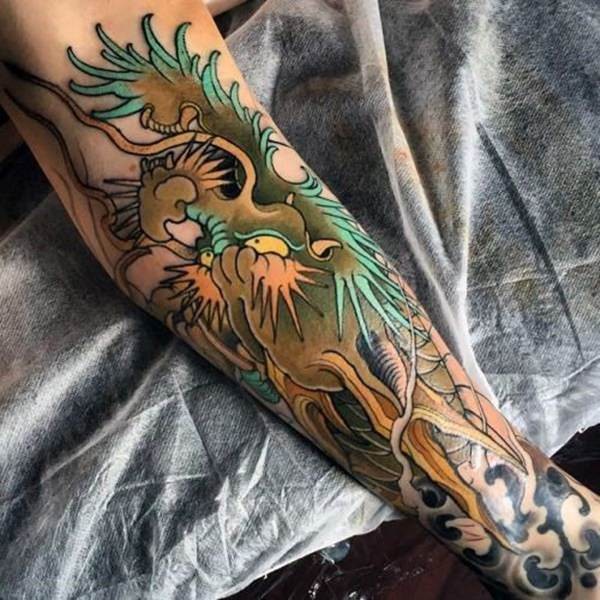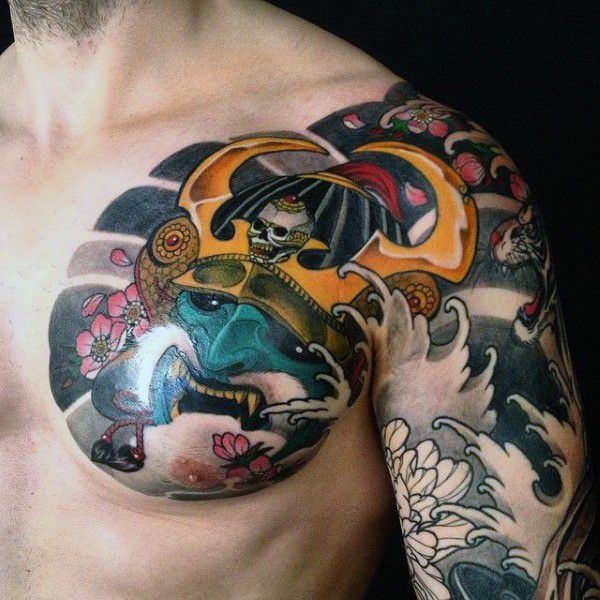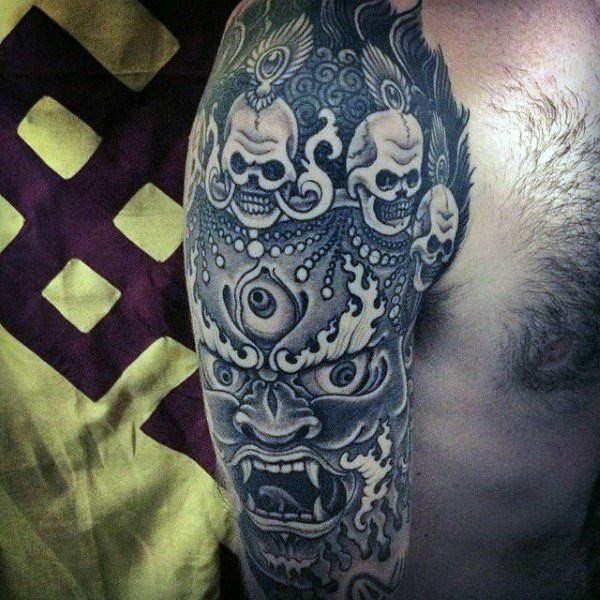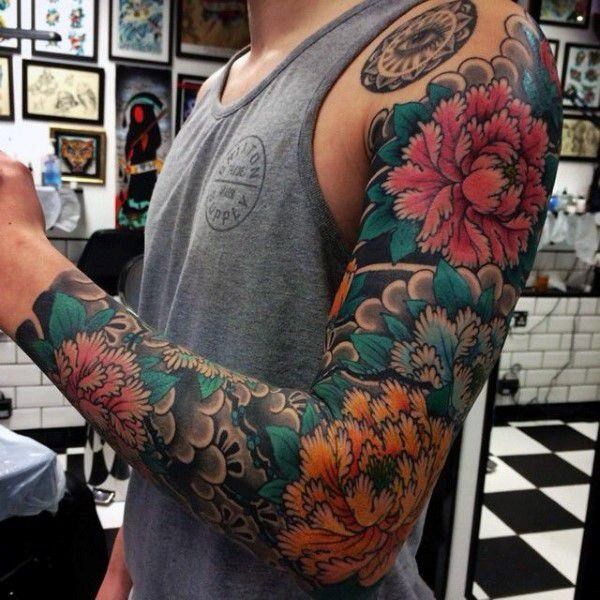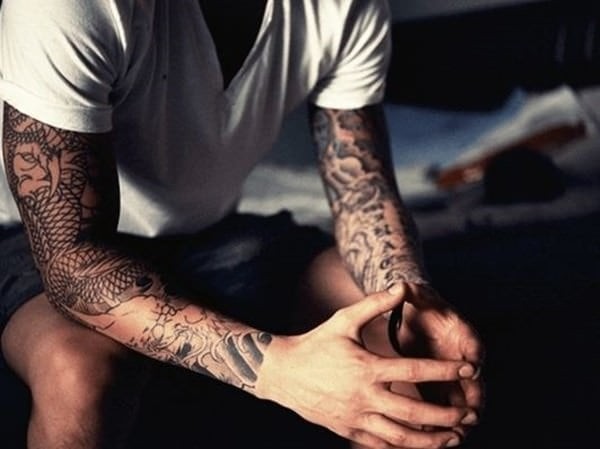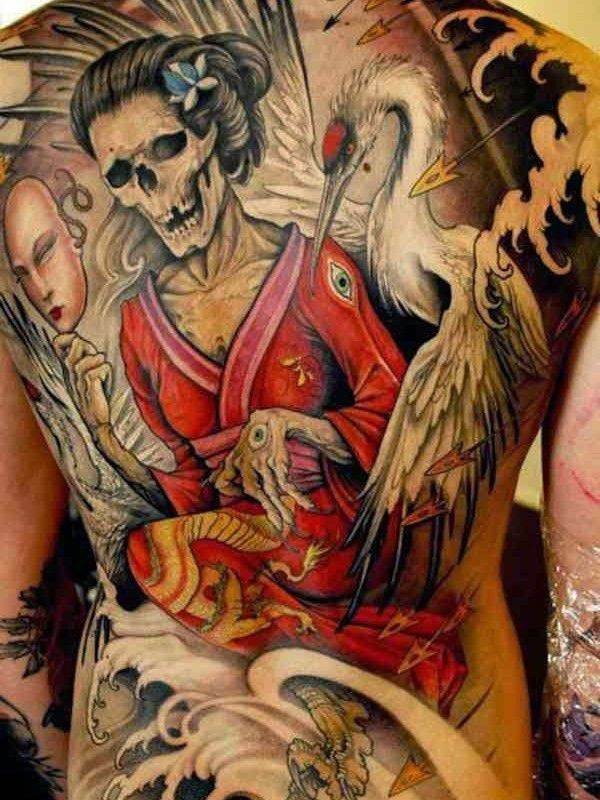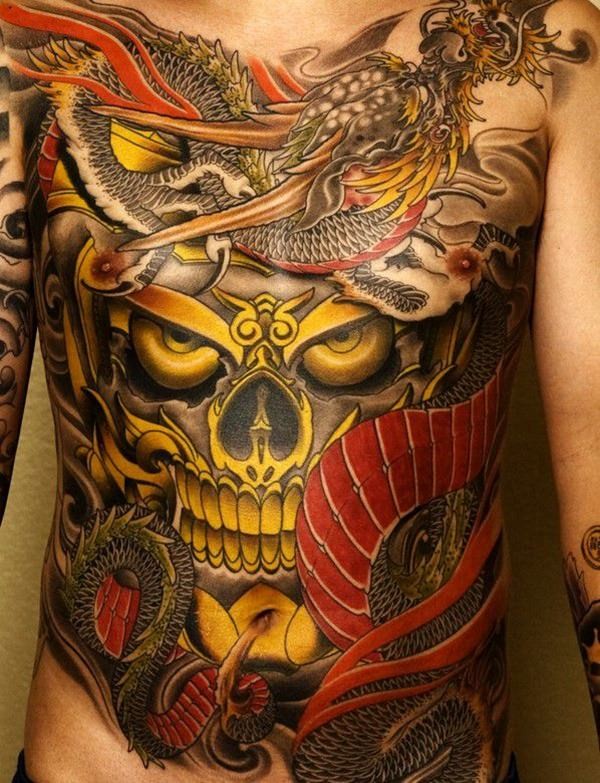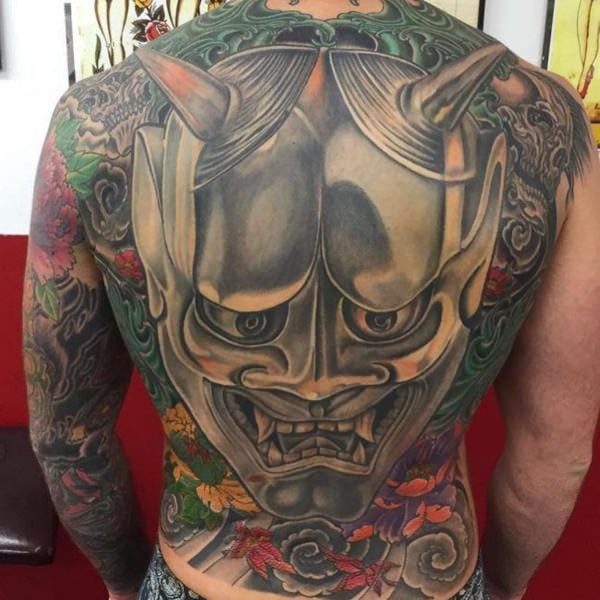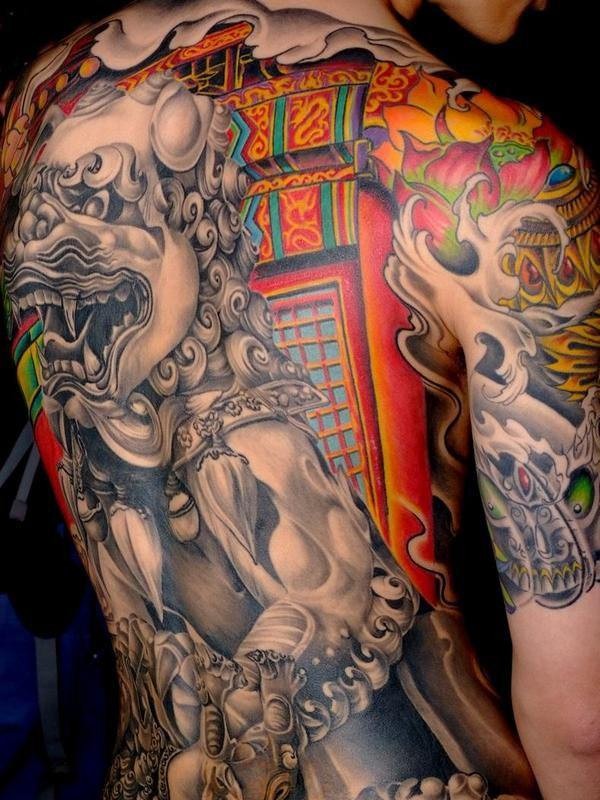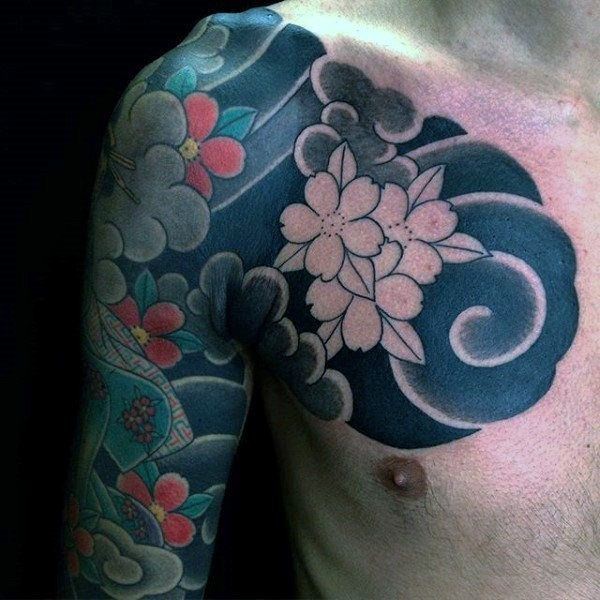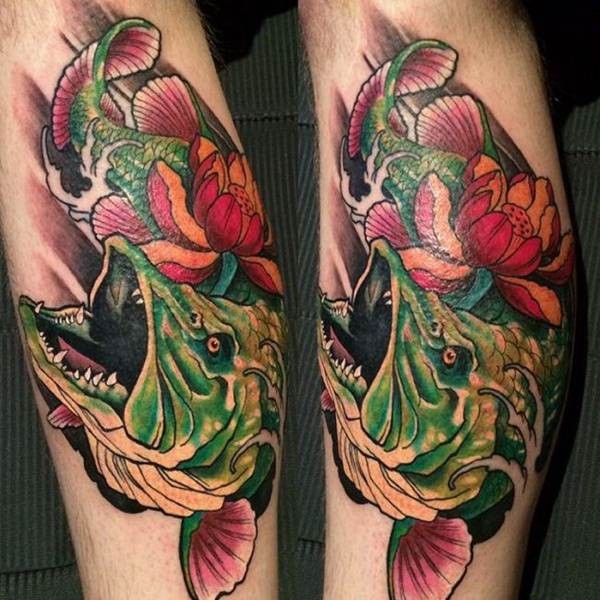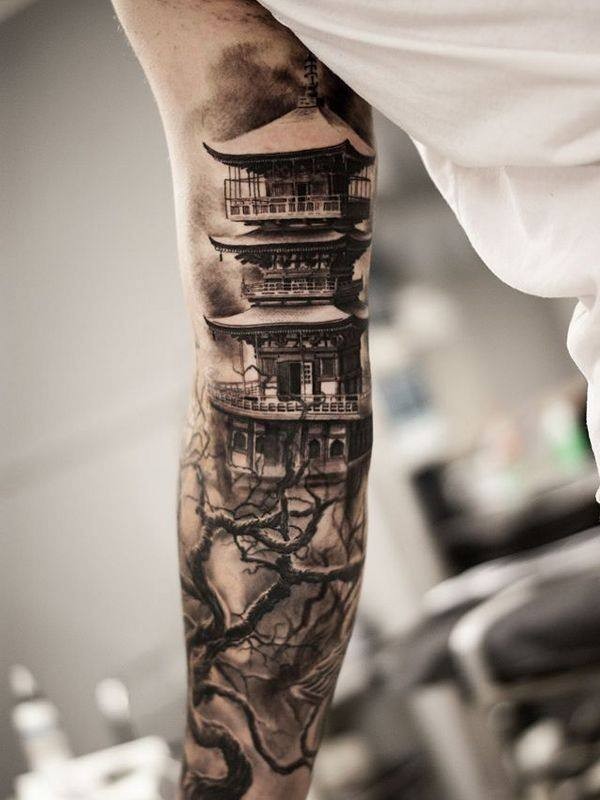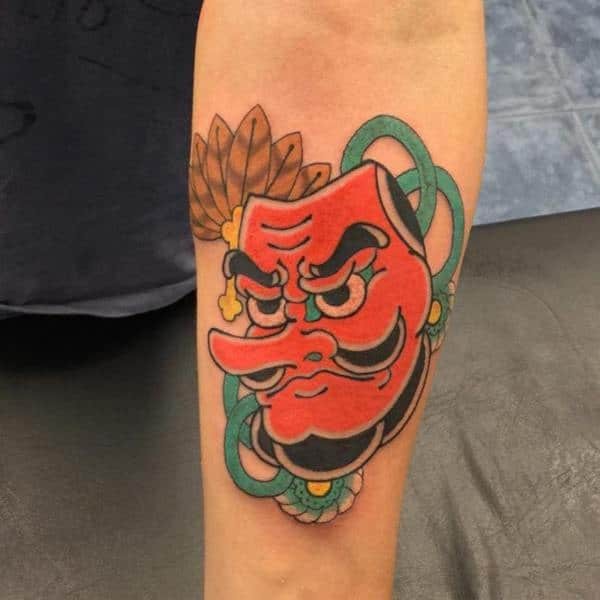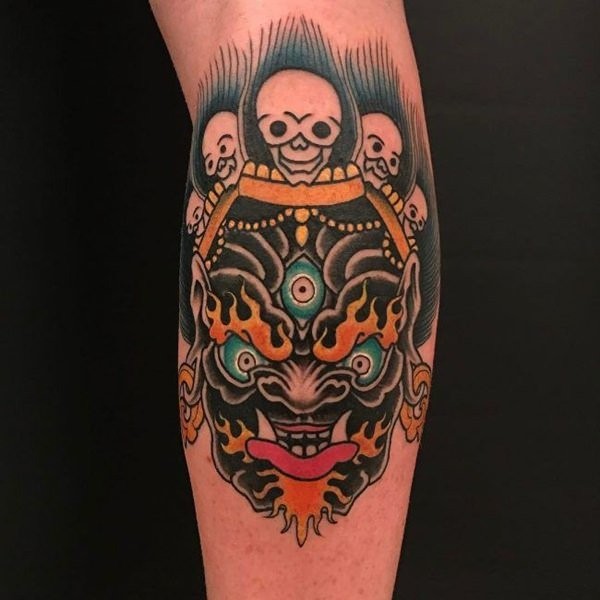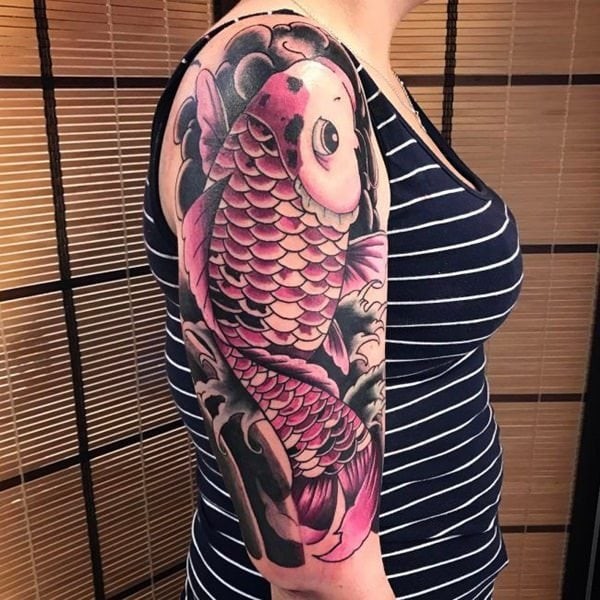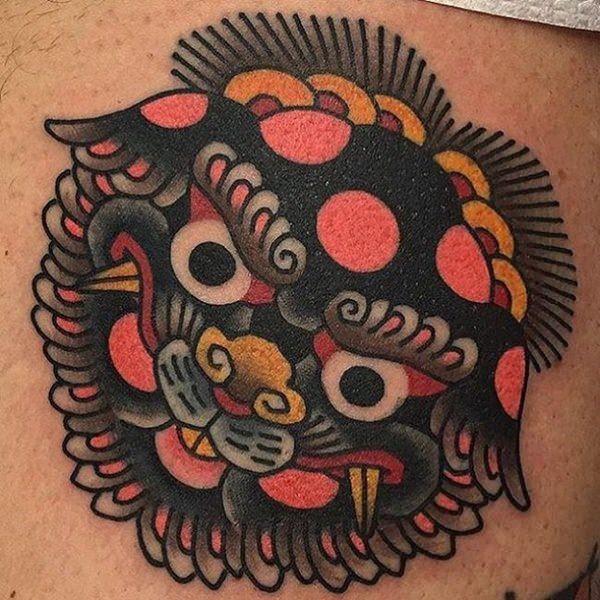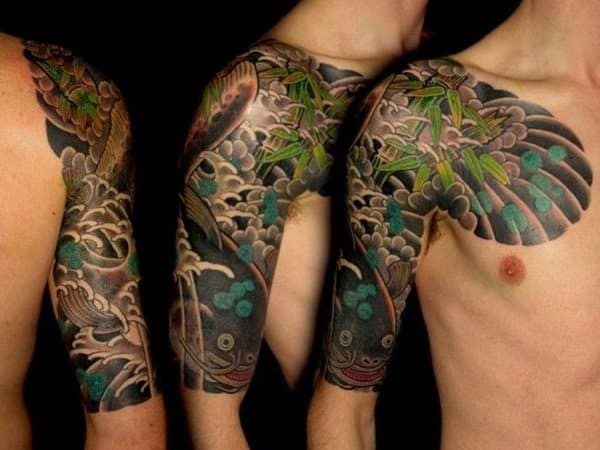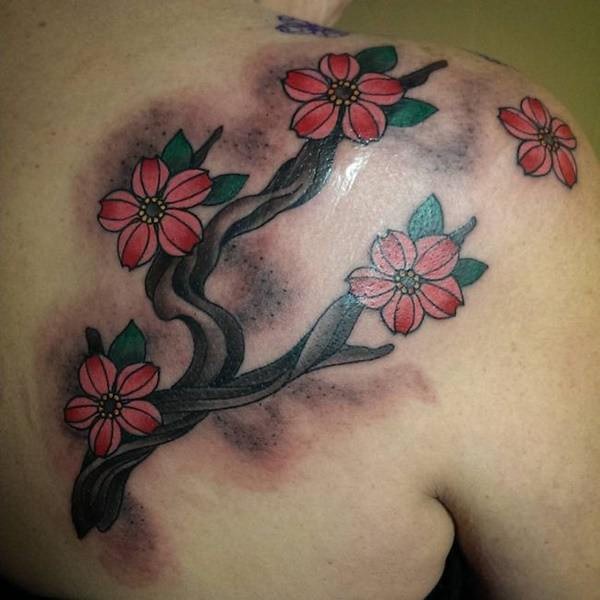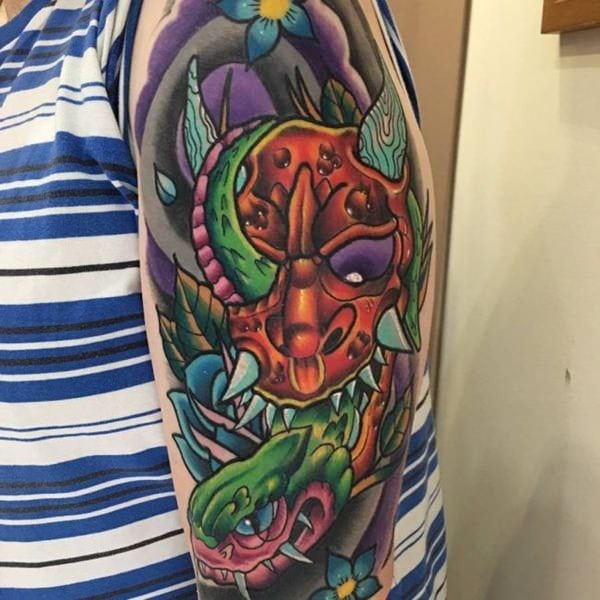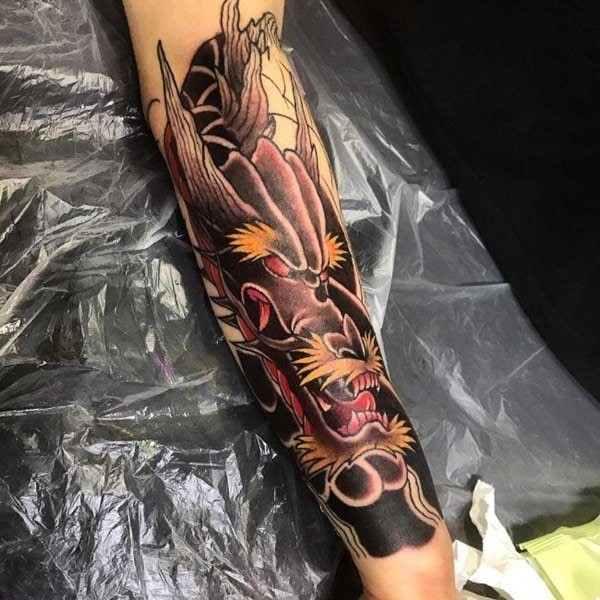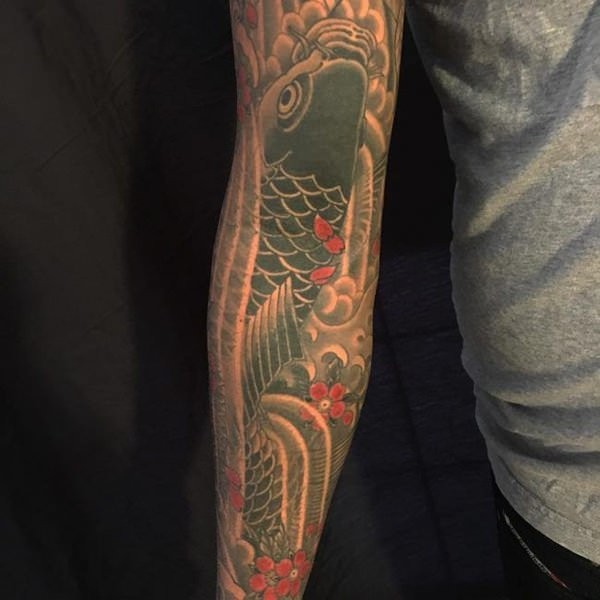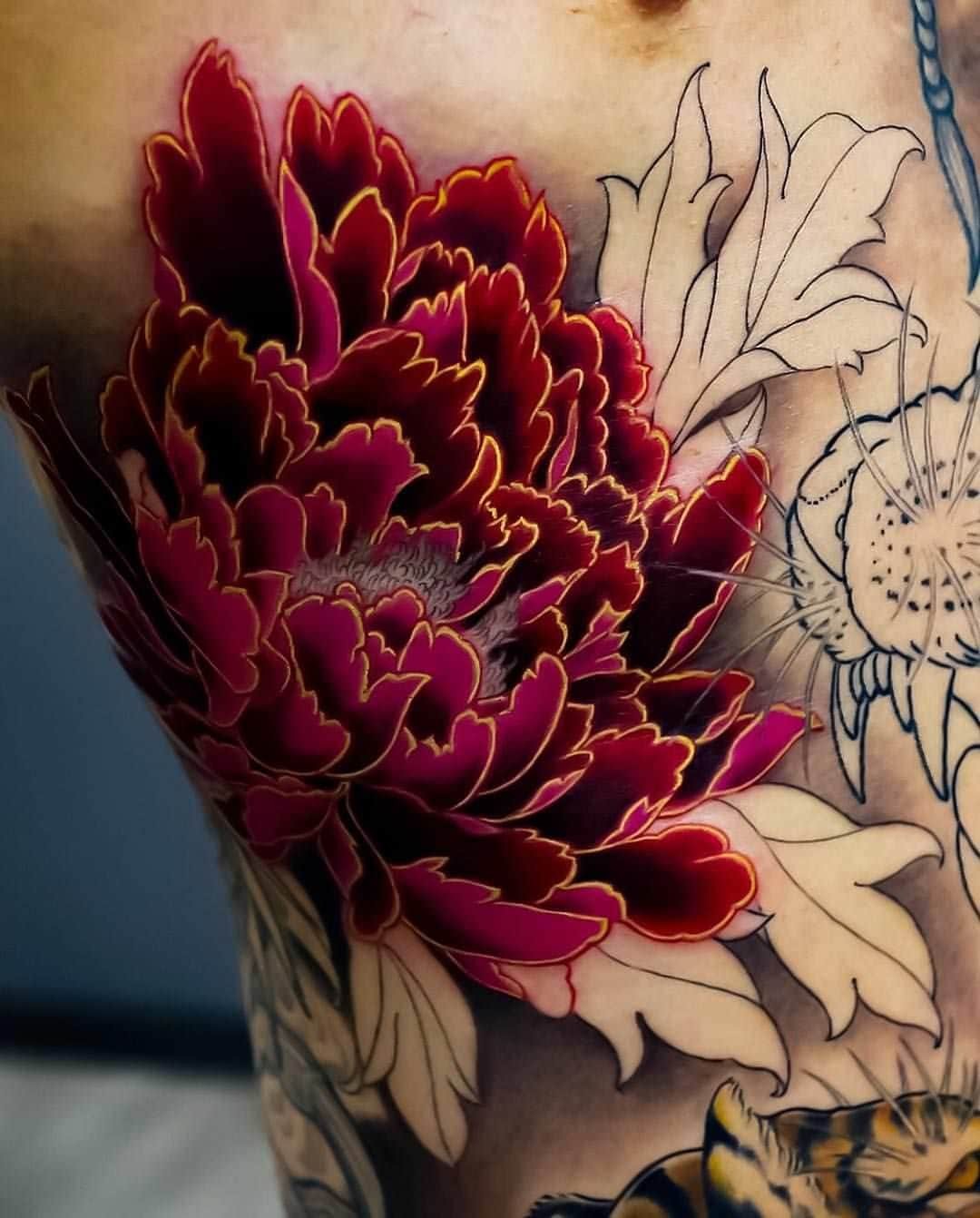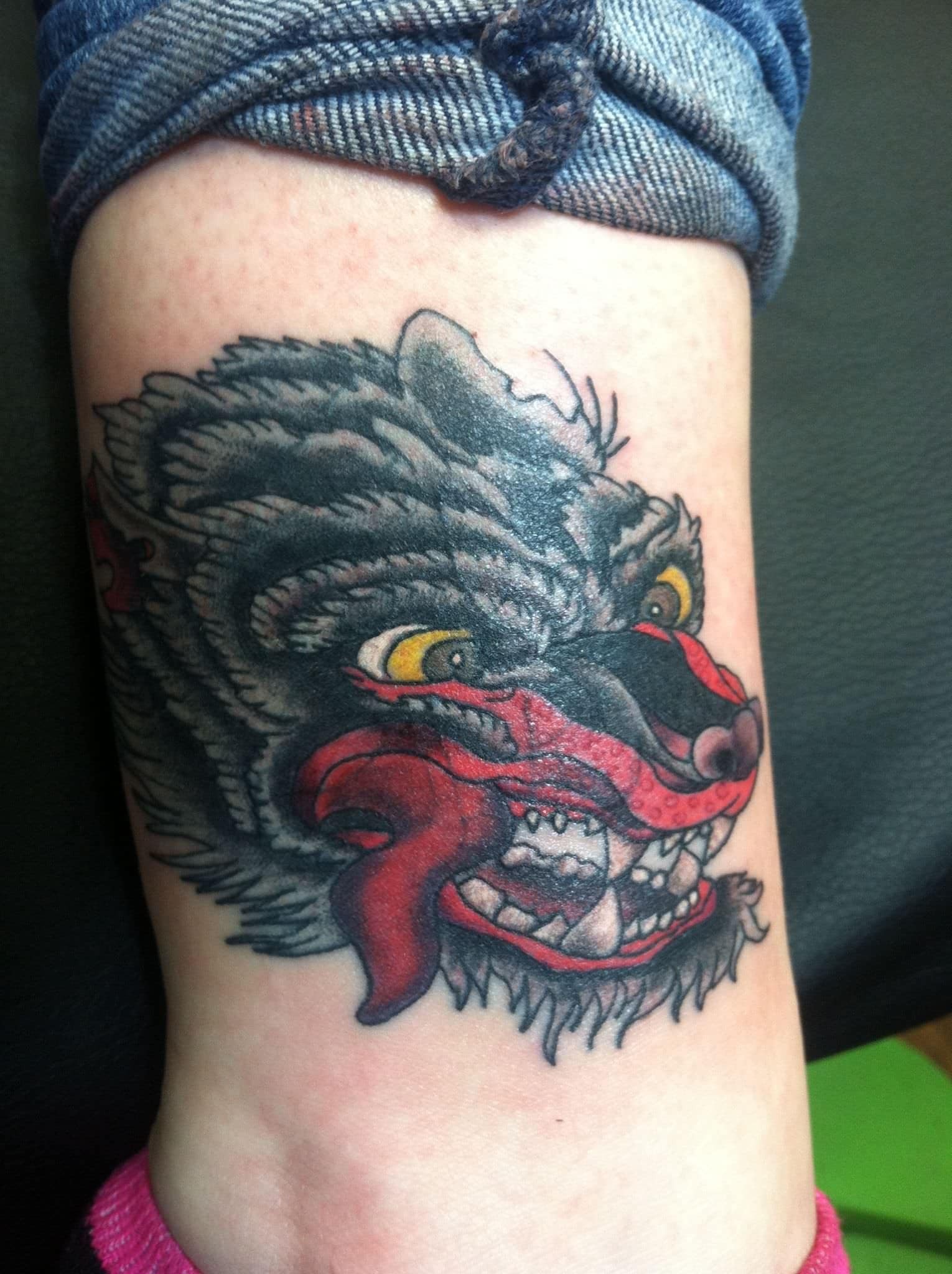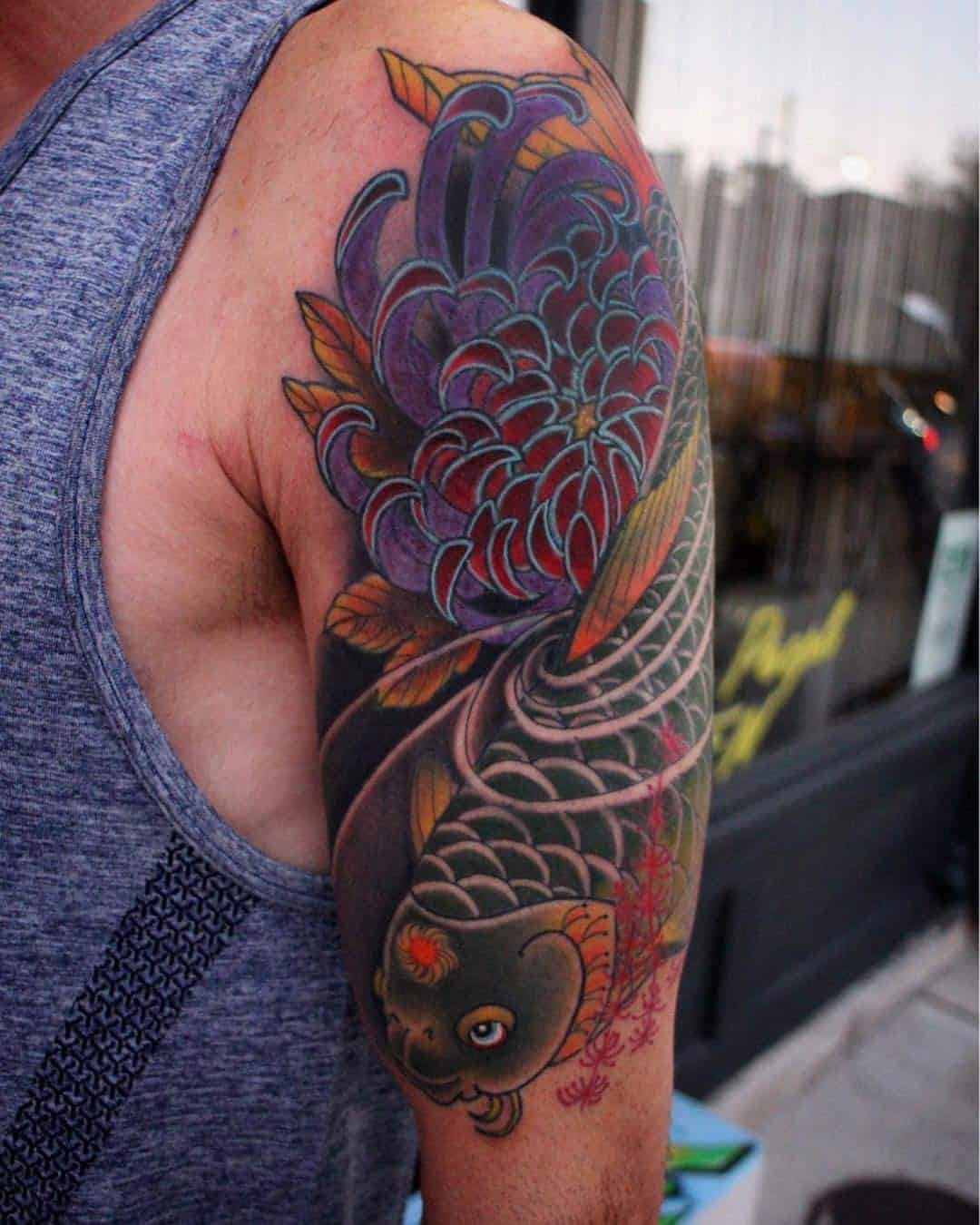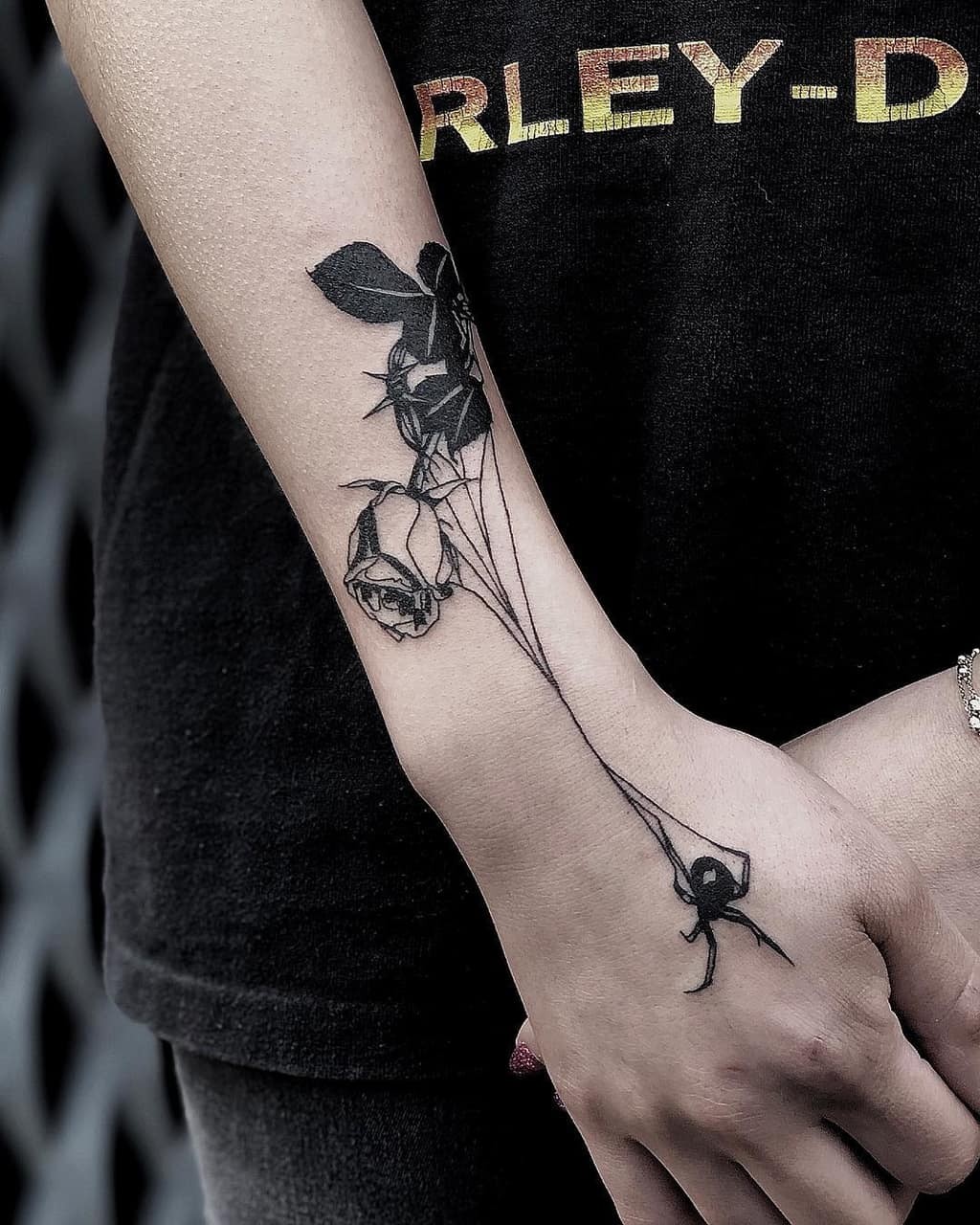Traditional Japanese Tattoo Of A Lantern
A radiant lantern adorns the chest, its crimson flames burning bright. The intricate design features a harmonious blend of grey clouds and floral motifs, with the artist’s skillful use of intense black ink creating a striking visual effect. The adjacent wolf tattoo on the arm is a masterpiece of detailing, adorned with a regal crown of feathers that exudes power and majesty.
As the lantern casts its light, guiding the wearer through life’s journey, the Japanese word ‘Okami’ – meaning wolf – serves as a symbol of protection. This unique design seamlessly integrates artistry and symbolism, making it an attractive choice for those seeking a meaningful tattoo. Another captivating alternative is a full sleeve design inspired by traditional Japanese art.
Bold colors and intricate patterns come together to create a visually stunning piece, featuring monochromatic roses in the background contrasting with flames emerging from the lantern. This striking artwork would make a memorable addition to any arm.
Enticing Japanese Dragon Tattoos
In Japanese culture, the enigmatic dragon tattoo holds a rich significance, shrouded in multiple interpretations. The versatility of these mythical creatures allows for diverse portrayals, depending on personal taste. Here, a striking monochromatic dragon is rendered in fine red lines, set against a picturesque backdrop of cherry blossoms. The delicate branches are defined by black ink, while the vibrant flowers burst with pink vitality.
This stunning artwork would make a captivating canvas for the back. Alternatively, a formidable dragon is intricately inked on the wearer’s back, its menacing features accentuated by black lines and detailing. The pair of flowers adds a touch of femininity to the piece. In Japanese tradition, these dragons are believed to bring good fortune to the wearer, repelling evil spirits. As with any traditional design, the size can be adjusted according to personal preference.
Traditional Japanese Snake Tattoos
Incorporating traditional Japanese elements into a unique tattoo design is always a fascinating option. For those who seek to blend femininity with snake symbolism, consider a striking peony-inspired piece. A snake wraps elegantly around a vibrant flower at its center, showcasing an exquisite color palette that shines through the use of blue and red ink.
The ‘Hebi’ or Japanese term for snakes represents wisdom and good fortune, while the fusion of snake and flower embodies the duality between beauty and desire. This captivating design will undoubtedly elevate your personal style. For a more versatile option that suits both men and women, consider a venomous serpent entwined around sunflowers. The striking contrast between the snake’s greenish hue and the bright yellow petals creates a visually appealing piece.
As in Japanese culture, snakes are seen as protectors of wealth and treasures, making this design an excellent choice for those seeking to symbolize prosperity. This beautiful tattoo can be placed along the length of your leg or arm, allowing it to become a unique statement piece.
Traditional Japanese Koi Tattoo
Koi fish tattoos hold a unique significance in Japanese culture, often featuring alongside sea waves and floral motifs to create striking designs. In this piece, the koi fish is rendered in a rich red hue, complemented by the artistic touch of red flowers. The ripples surrounding the fish are executed in contrasting black ink, adding depth and dimensionality to the artwork. For those seeking a traditional Japanese sleeve tattoo featuring a realistic koi fish, this design is an excellent choice.
A golden koi glides effortlessly along the wearer’s arm, accompanied by undulating waves at its base. The harmonious blend of colors lends an air of realism to this piece of Japanese tattoo art. Interestingly, the koi’s movement downstream, in tandem with the flowing water, serves as a poignant reminder that the wearer has already navigated life’s challenges and emerged victorious.
Traditional Japanese Tattoo Of A Roaring Tiger
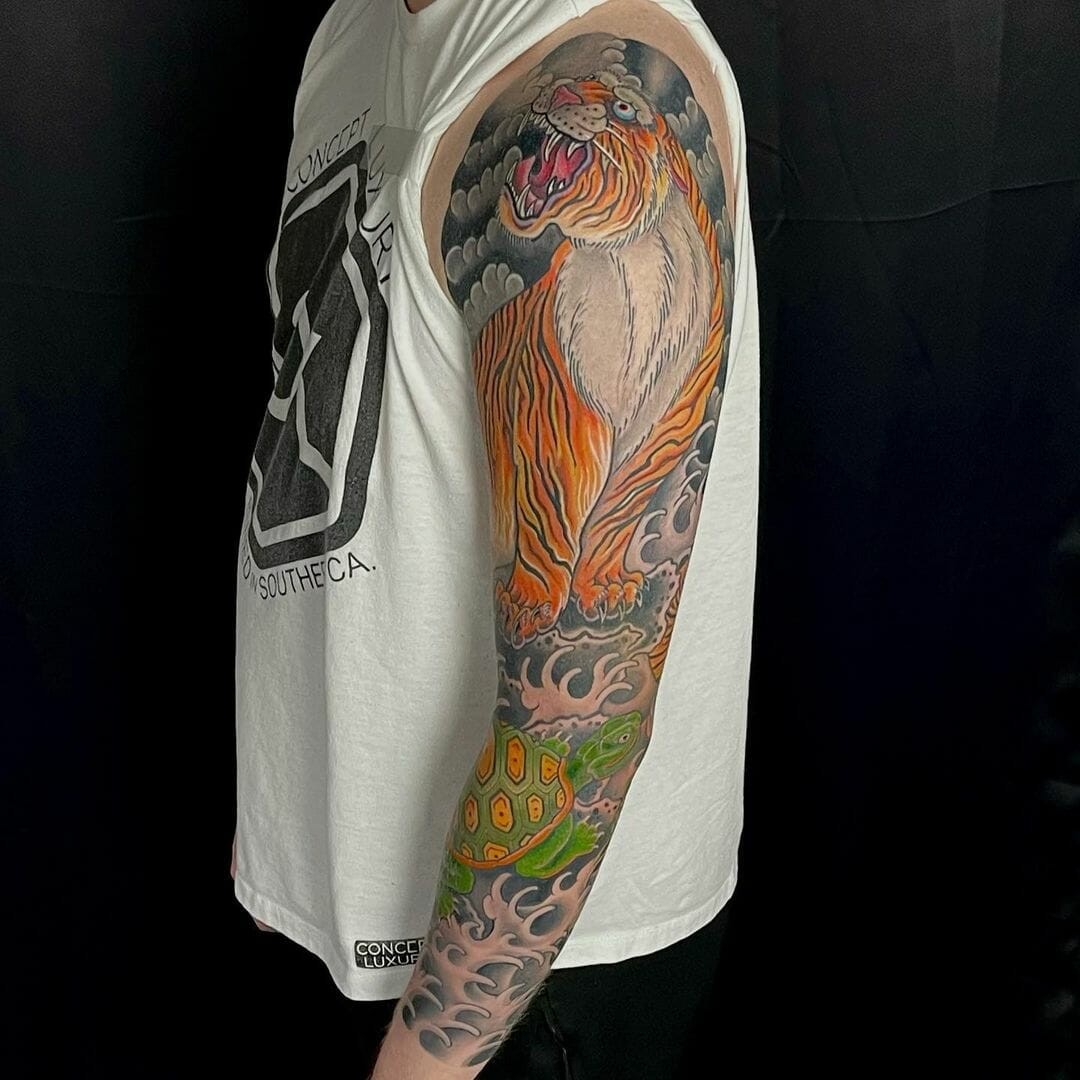
In Japanese tradition, the tiger is considered a powerful symbol of nature and the ruler of the cosmos. This majestic creature is often depicted in traditional art with its distinctive orange and black stripes. A small turtle may also be incorporated into the design to add an extra layer of meaning. For those looking to create a unique tattoo design, combining a roaring Japanese tiger with a fiery dragon can result in a truly striking and meaningful piece.
Traditional Japanese Skull tattoo
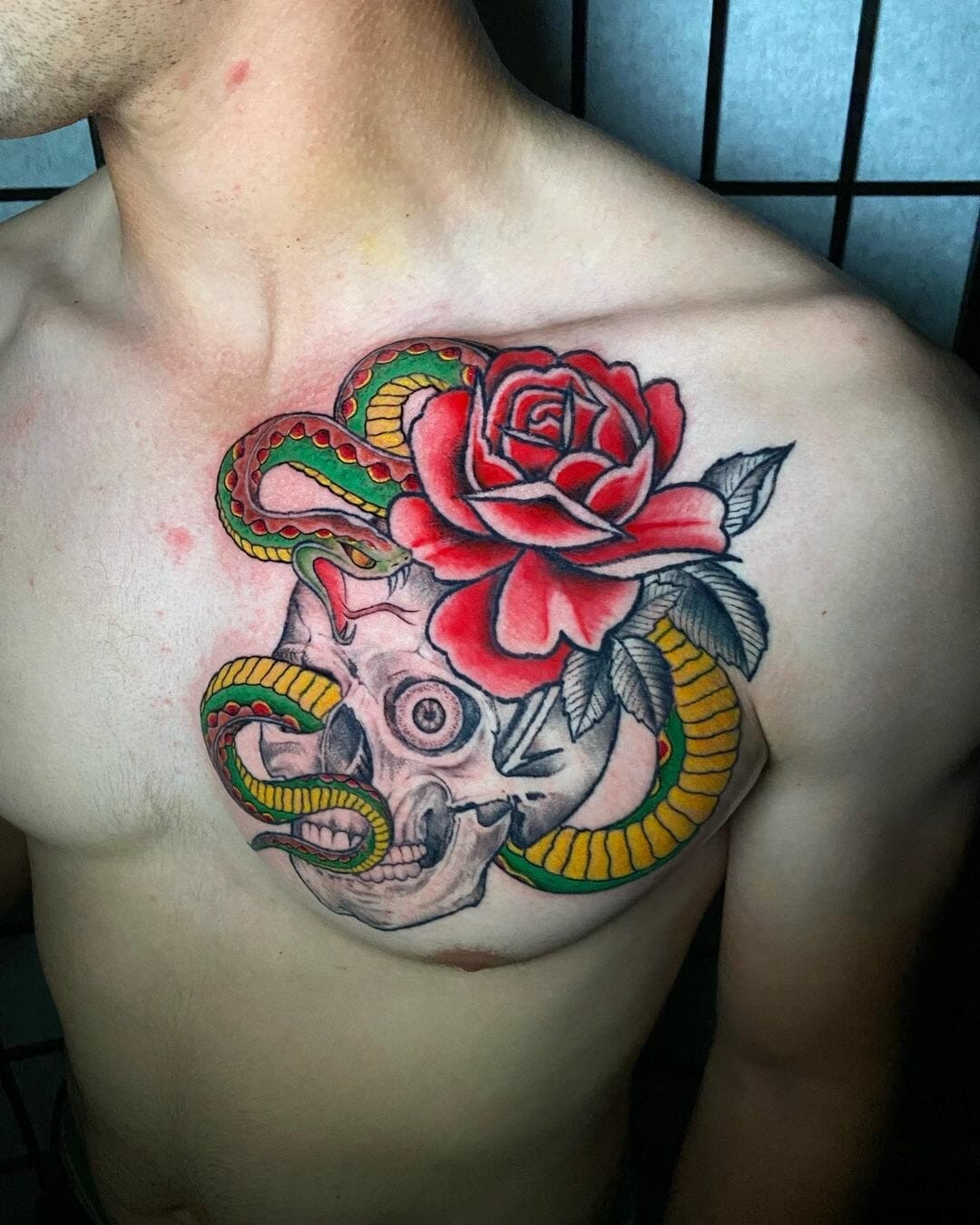
A striking tattoo design features a skull grasping a prominent flower, from which a serpent emerges. The skull’s monochromatic, intricately shaded inkwork contrasts with the vibrant colors surrounding it. The snake’s forked tongue, protruding from the skull’s mouth, adds a dramatic flair to the overall piece. This singular design successfully combines three distinct elements: the skull, the flower, and the serpent. The artist’s skillful inking brings this beautiful artwork to life.
Neo-traditional Japanese Tattoo Of A Floral Butterfly
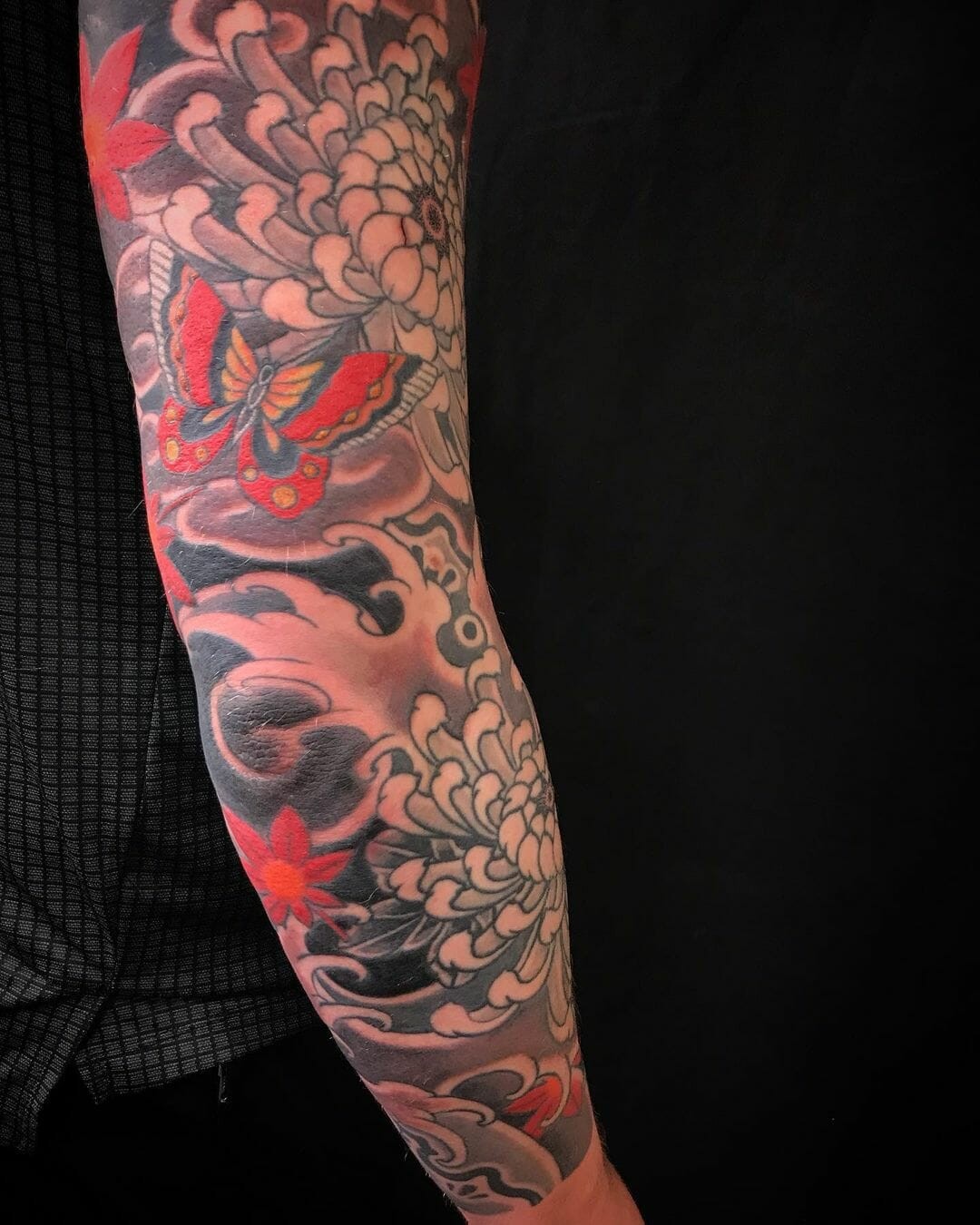
In Japanese tattoo culture, a breathtaking full sleeve floral design is a timeless favorite. This stunning piece of body art features a delicate balance between nature’s beauty and artistic flair. A butterfly, its vibrant red wings glowing like embers, appears to be lost in a lush landscape of chrysanthemums and maples. The flowers, with their petals delicately inked and subtly shaded, provide a serene backdrop for the butterfly’s striking presence.
Traditional Japanese Mask Tattoo Designs
In Japanese folklore, the Oni mask has been a beloved subject for centuries, simultaneously representing both benevolent and malevolent spirits as well as a symbol of protection. This unique design combines the ferocity of the oni mask with the elegance of surrounding flowers. The piercing yellow gaze, surrounded by blazing flames, adds to its intimidating aura.
While the chest is a popular placement for this design, it can also be inked along the leg or back, where there’s sufficient space to capture the intricate details.
The oni mask’s intriguing presence is often felt when inked along the length of the arm, conveying the wearer’s inner ferocity through its fuming eyes. The prominent display of large fangs in its massive mouth only amplifies its fierce demeanor.
To create a striking visual effect, tattoo artists often use white ink to subtly highlight the oni mask’s features. A full sleeve featuring an Oni mask is an exceptional Japanese tattoo concept worth exploring.
Traditional Japanese Monk Tattoo
The allure of traditional Japanese full-body tattoos lies in their intricate detailing and symbolic representation. This style is often characterized by realistic depictions of spiritual deities and monks, such as the two featured designs. The first tattoo showcases a monk with remarkable realism, while the second design presents a more contemplative figure, clad in white and adorned with a crown, eyes closed in devotion.
Both pieces seem to convey a sense of reverence, with the wearer potentially seeking guidance or connection with a higher power through their art. For those drawn to these Irezumi tattoos, they offer a unique opportunity to express one’s spirituality and values through a striking work of body art.
Traditional Japanese Samurai Tattoo
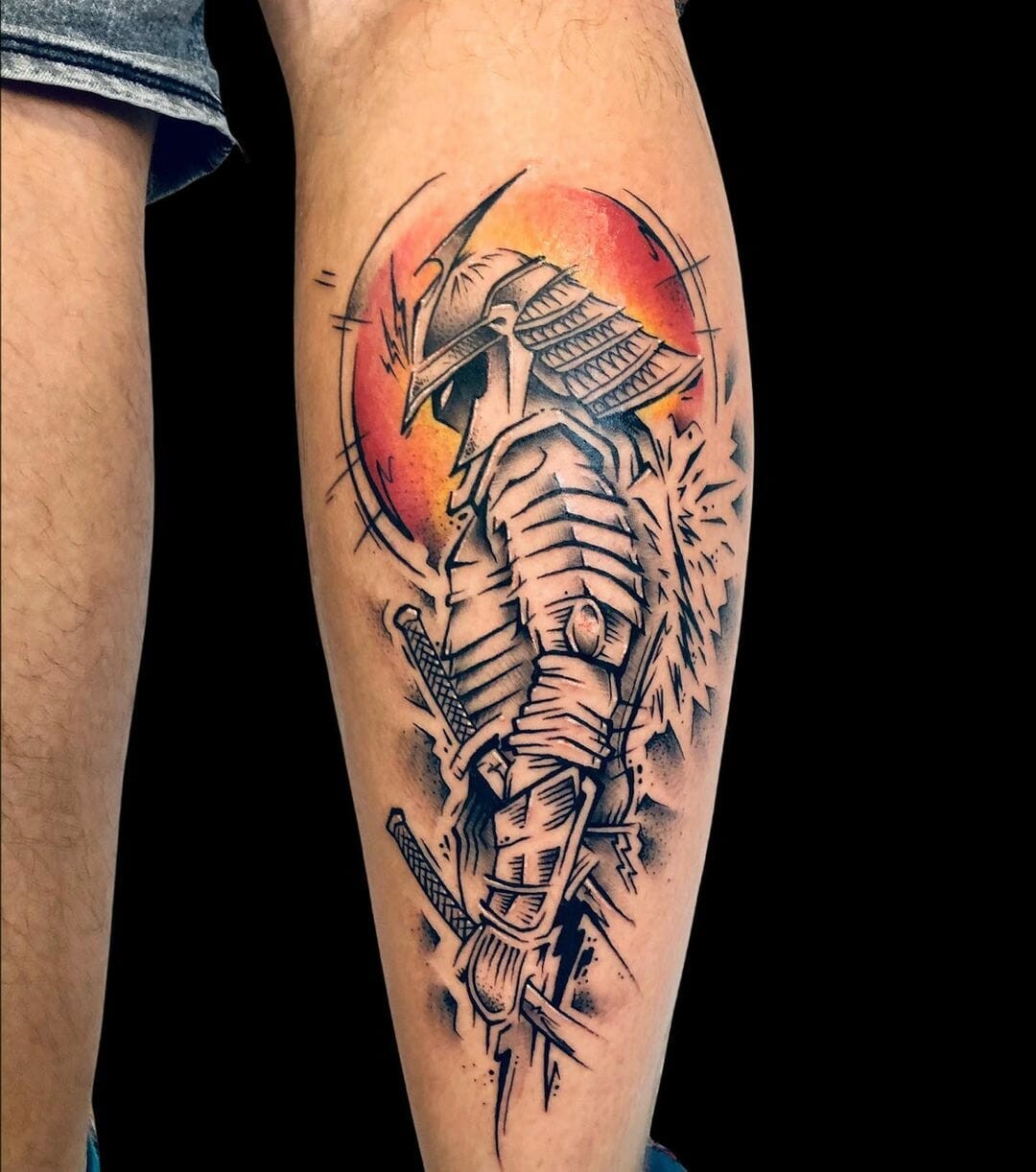
In feudal Japan, during the 12th century, the samurai class emerged as a powerful force on the battlefield. Their legendary exploits and unwavering bravery have captivated historians and tattoo enthusiasts alike. A samurai warrior, clad in protective armor, stands poised for battle, his monochromatic figure rendered with intricate detail. The gleaming halo that surrounds him adds a touch of vibrancy to this striking design.
For many, Japanese tattoos serve as a window into the country’s rich cultural heritage, mythology, and folklore. Skilled tattoo artists weave narratives through their work, resonating with people worldwide. Explore this curated selection of inspiring Japanese tattoo designs, a testament to the art form’s timeless appeal.
Need More Inspiration
What is a traditional Japanese tattoo?
For centuries, Japan has been home to a unique form of body art known as Irezumi or Horimono, which is characterized by bold lines, intricate patterns and vivid colors. The traditional style typically features mythical creatures like dragons, tigers, koi fish, and other animals, as well as floral and geometric shapes. While traditionally done in black and gray, some modern designs may incorporate subtle pops of color.
Each design holds symbolic meaning, often representing the wearer’s values or worldview. Beyond being stunning works of art, traditional Japanese tattoos hold significant cultural importance.
What is the history of traditional Japanese tattoos?
In the 17th to 19th centuries, Japan’s Edo period saw the birth of traditional Japanese tattoos, commonly referred to as Irezumi. Initially, this art form was linked to criminal activity, with outcasts and offenders using body ink to signal their status or warn others. The penalty for tattooing during this era? Death. Despite the risks, tattooing continued to evolve, eventually becoming a hallmark of Japan’s organized crime syndicates, known as yakuza.
Today, Irezumi has transformed into a globally recognized symbol of self-expression and cultural heritage, with celebrated artists like Horiyoshi III playing a key role in its popularity.
Are traditional Japanese tattoos painful?
The journey of obtaining a traditional Japanese tattoo can be quite arduous, largely dependent on the intricacy and magnitude of the design. A hallmark of Irezumi tattoos is their manual execution through the ancient technique of tebori. Unlike contemporary tattooing methods that rely on electric machines, tebori involves painstakingly tapping a stick with needles attached to it into the skin, rendering each stroke a deliberate act of artistic expression.
How much do traditional Japanese tattoos cost?
When it comes to traditional Japanese tattoos, cost can be quite unpredictable and dependent on several factors. While the final bill may range from $1,000 to $5,000 USD, size and complexity of the tattoo are just two key considerations that influence the price. Additionally, an artist’s level of expertise and reputation also play a significant role in determining the final cost.
As such, it is crucial to gather quotes from multiple artists and thoroughly research each option before making a decision.
What are some of the common designs found in traditional Japanese tattoos?
In traditional Japanese tattoos, a range of iconic motifs are commonly seen, including dragons, tigers, koi fish, carp, and snakes, which often symbolize balance, courage, or good fortune. Flowers, samurai warriors, and natural elements like waves and mountains also feature prominently. What’s more, many designs incorporate symbolism from nature to convey deeper meanings.
To add an extra layer of significance, Japanese kanji characters are frequently incorporated into the tattoo design, reflecting the wearer’s personal philosophy or sentiment.
